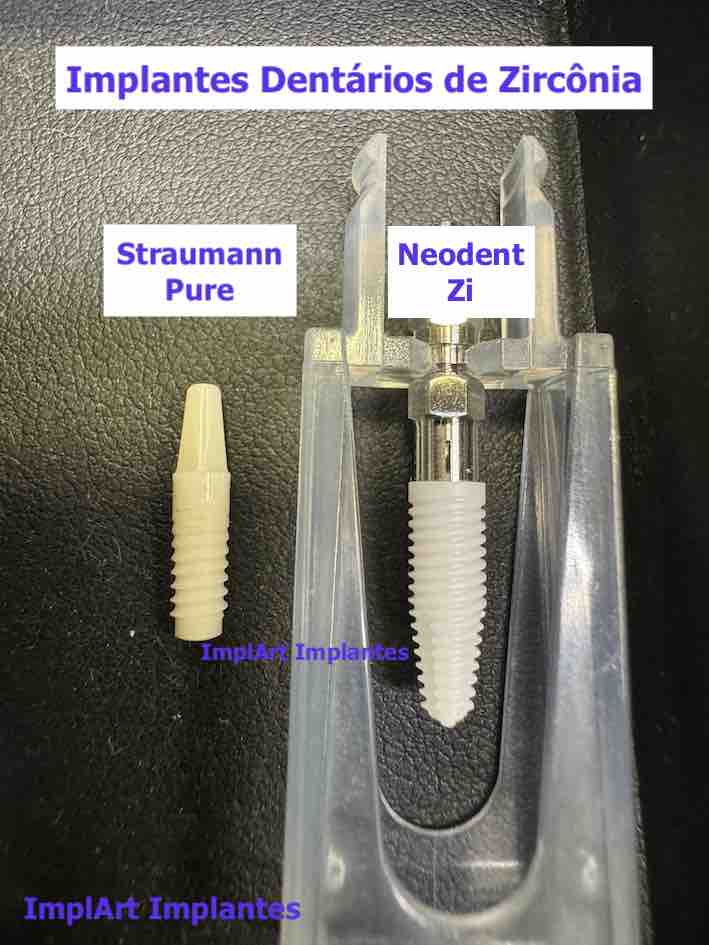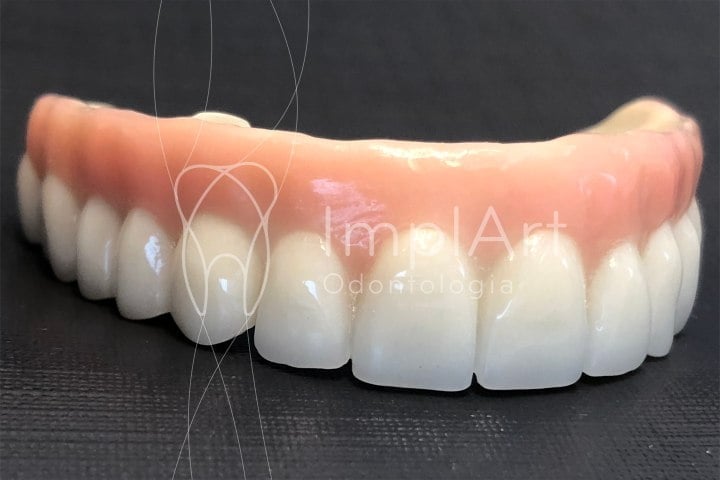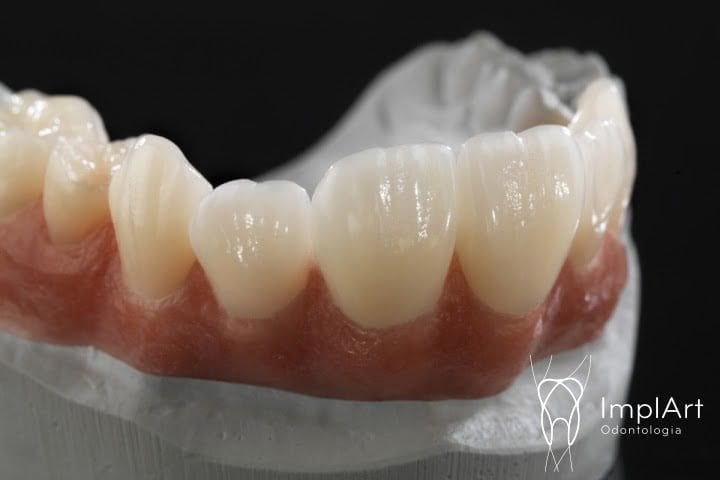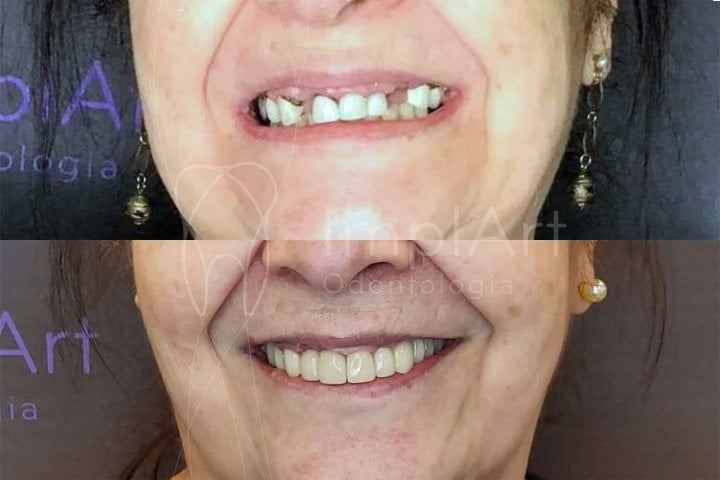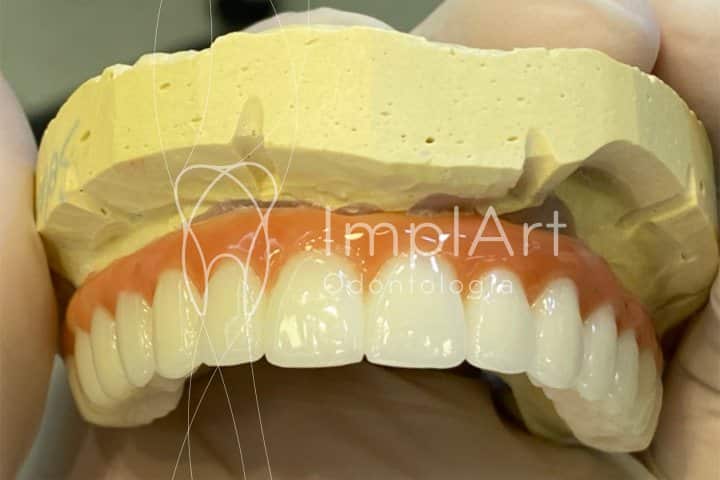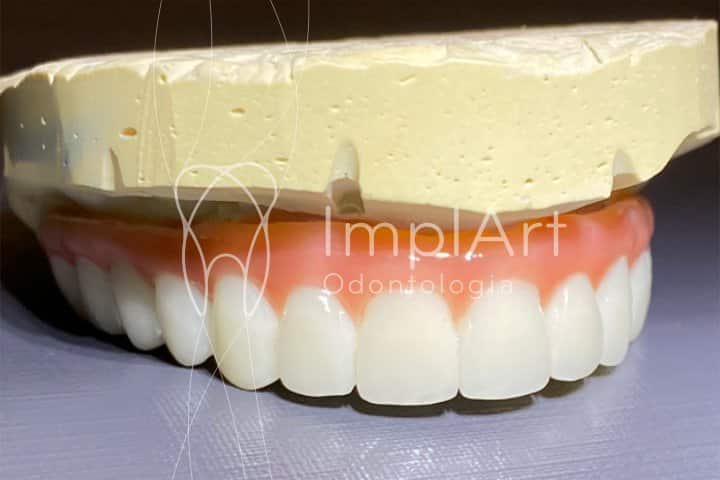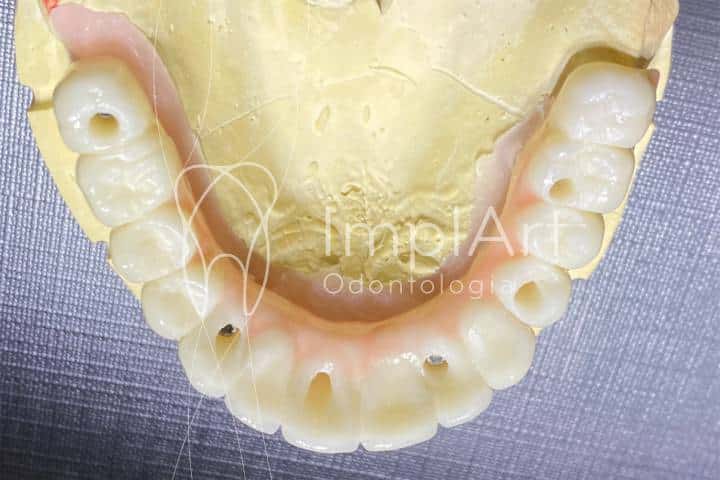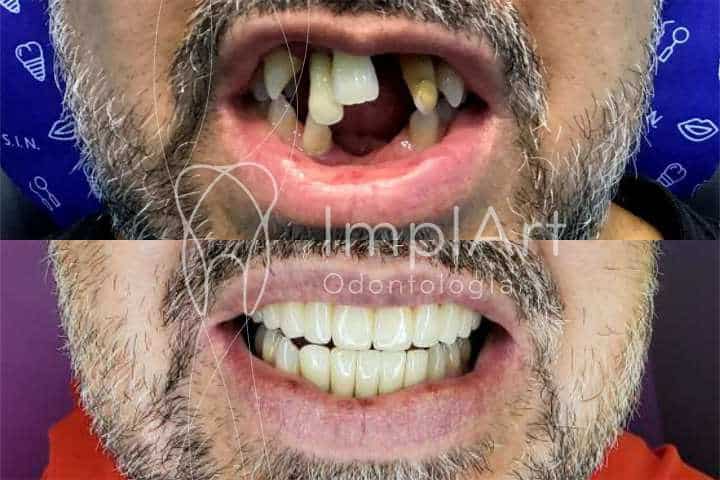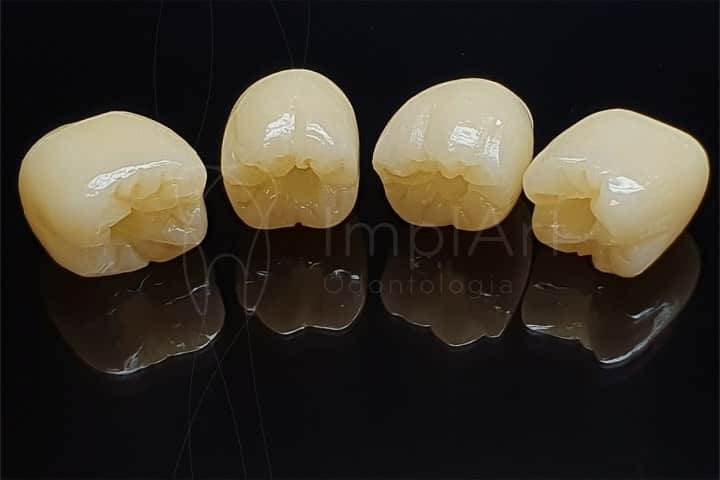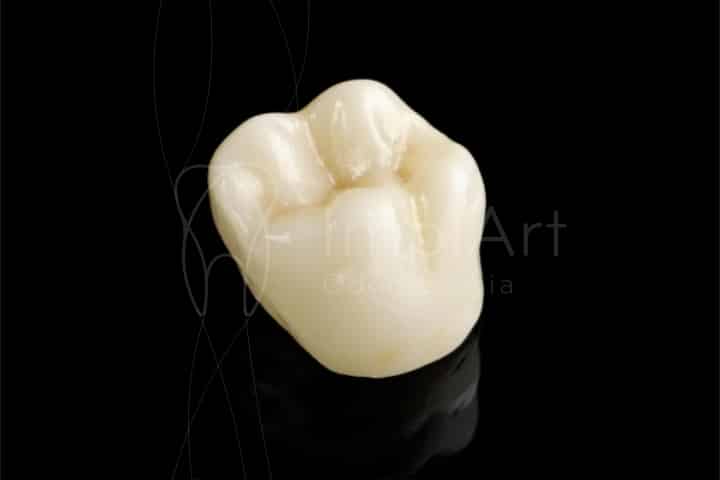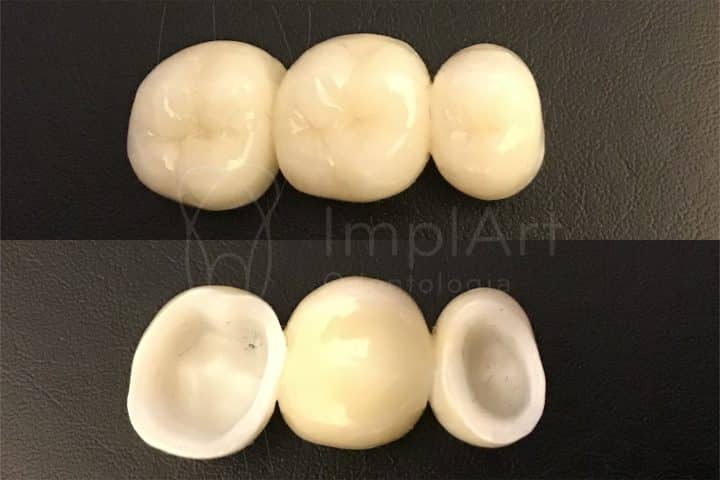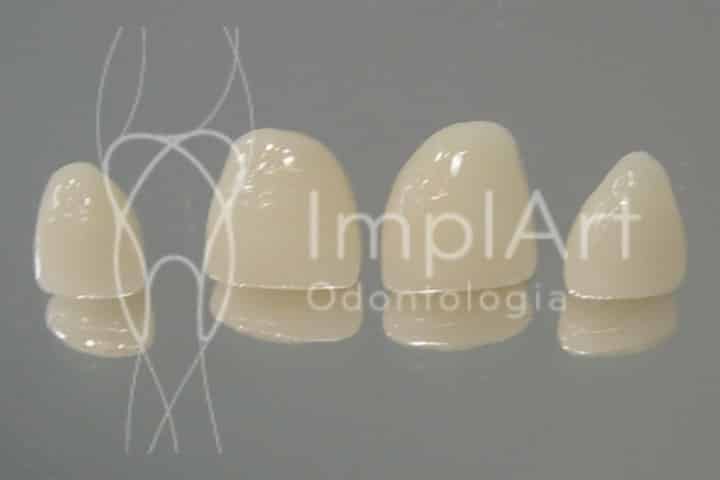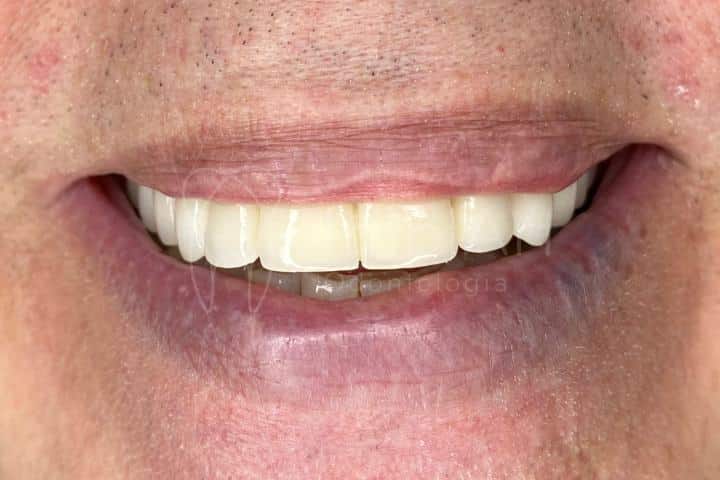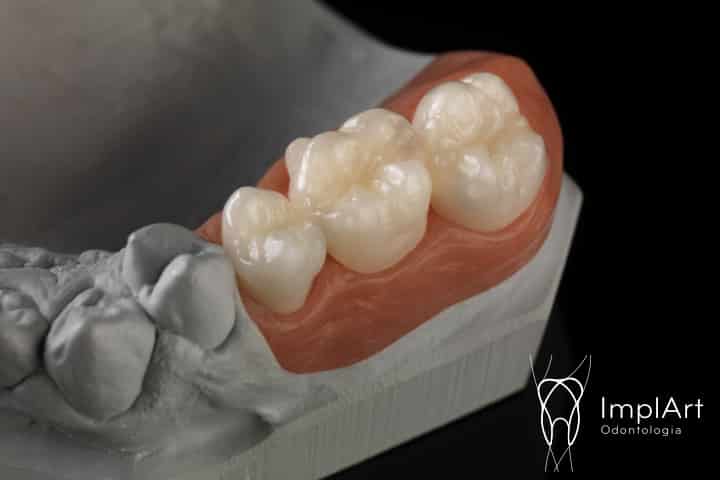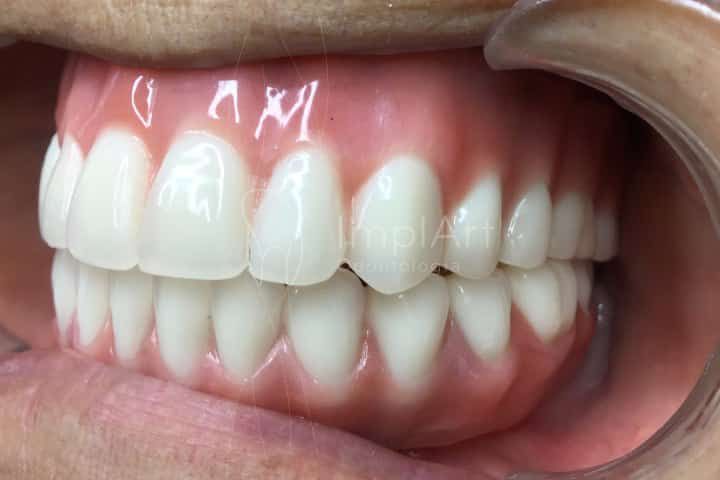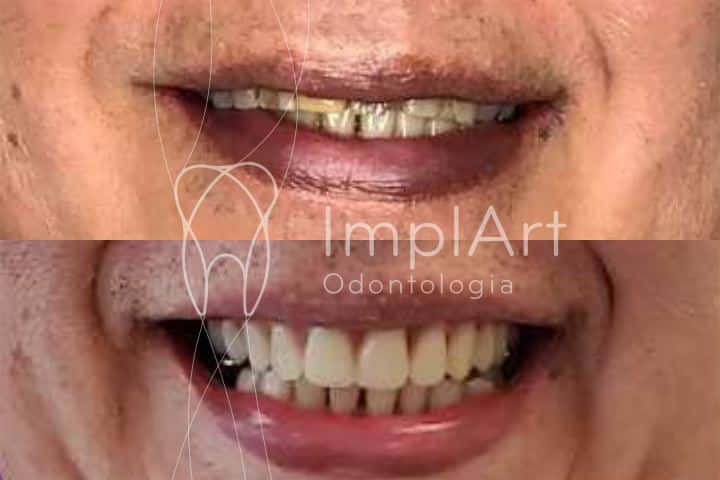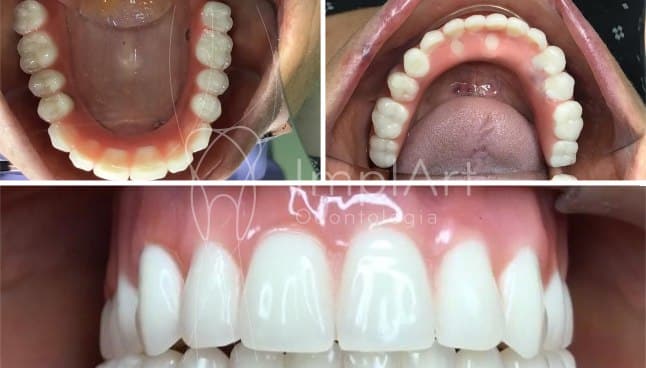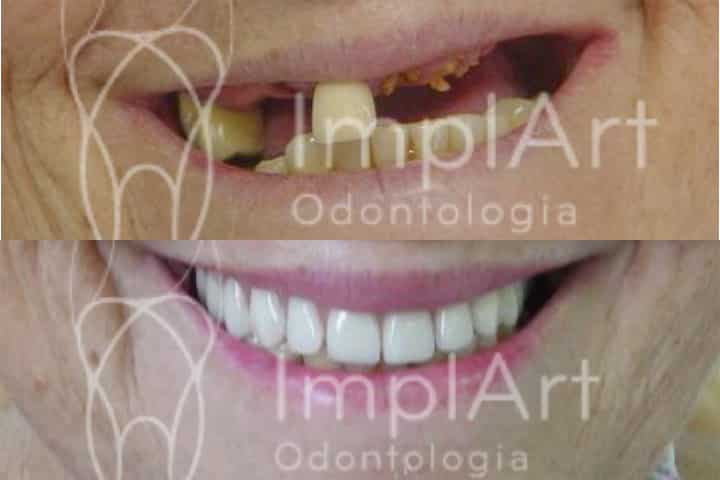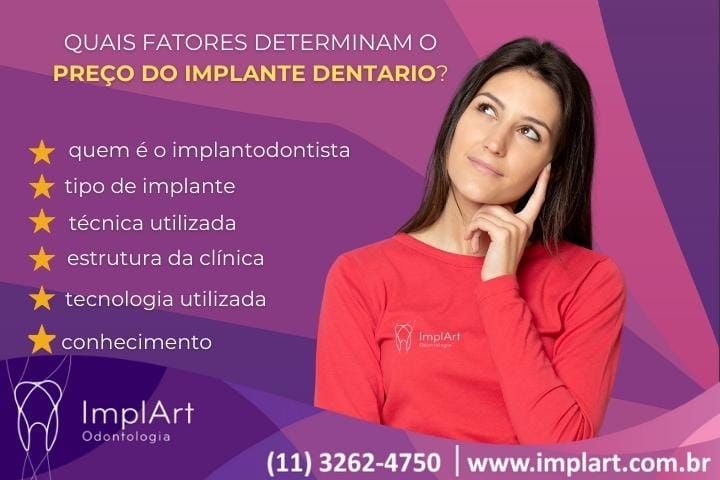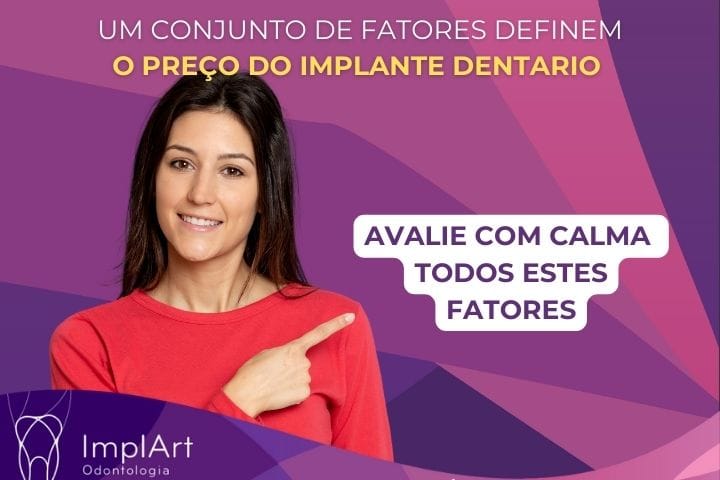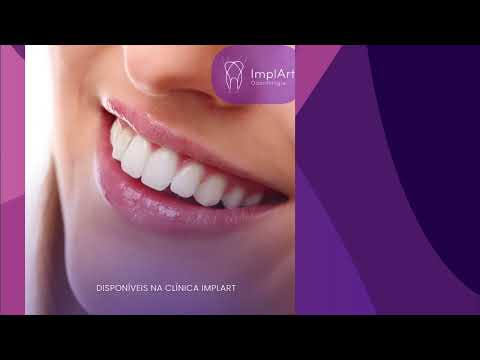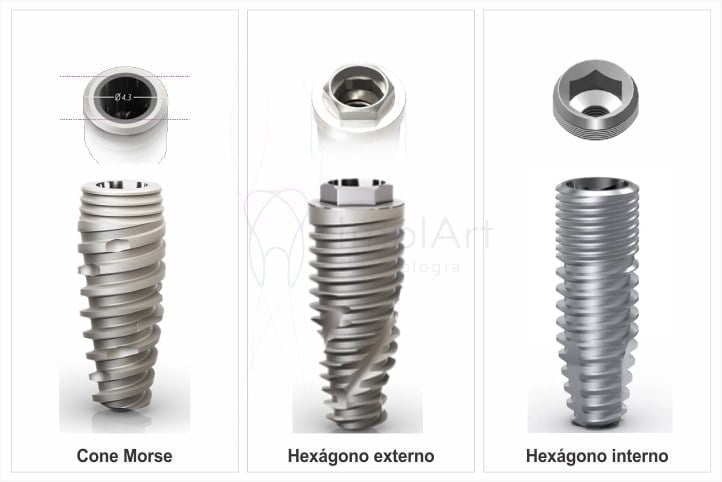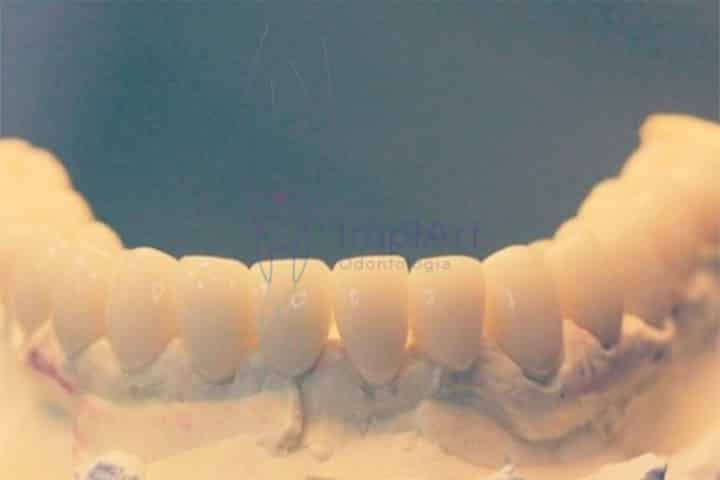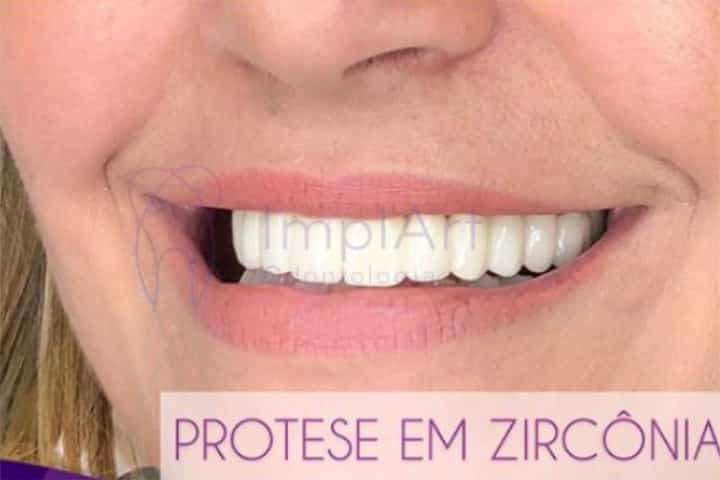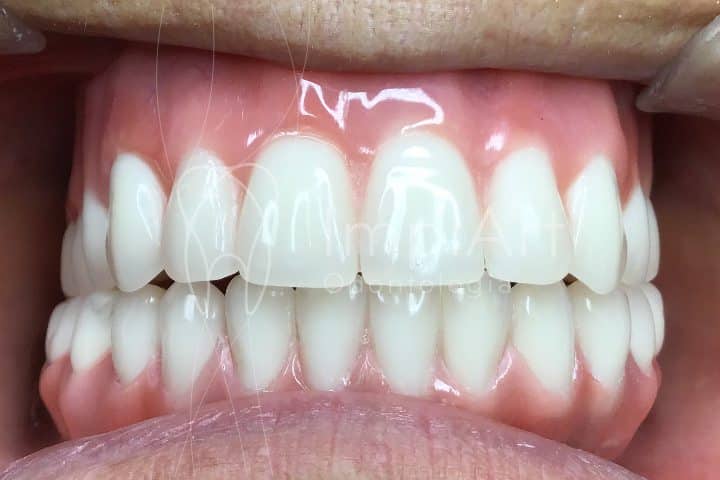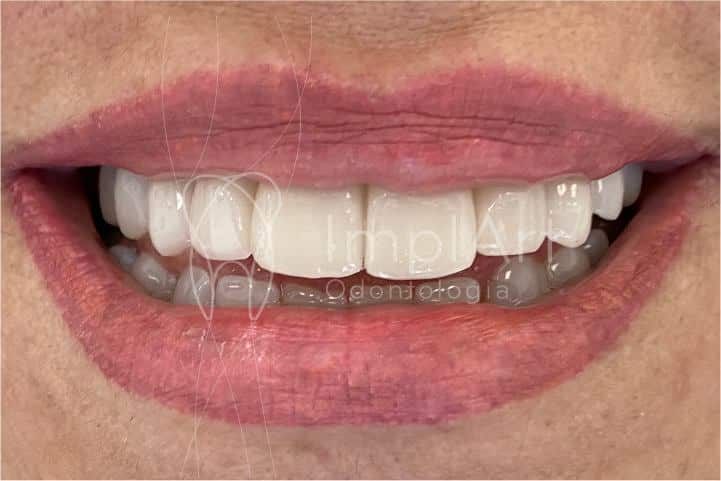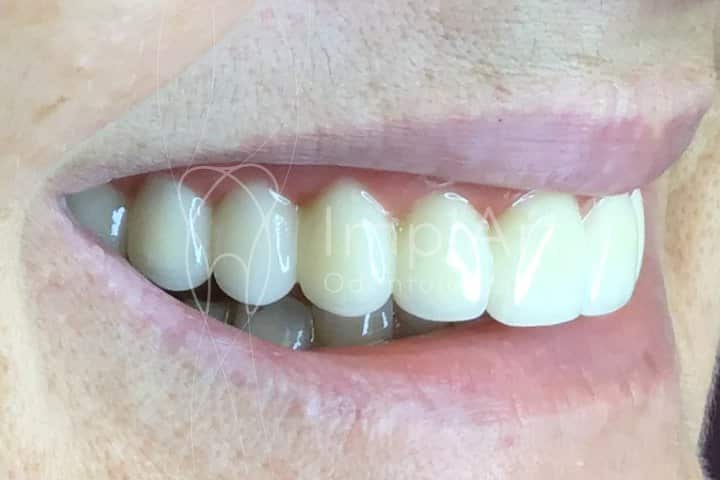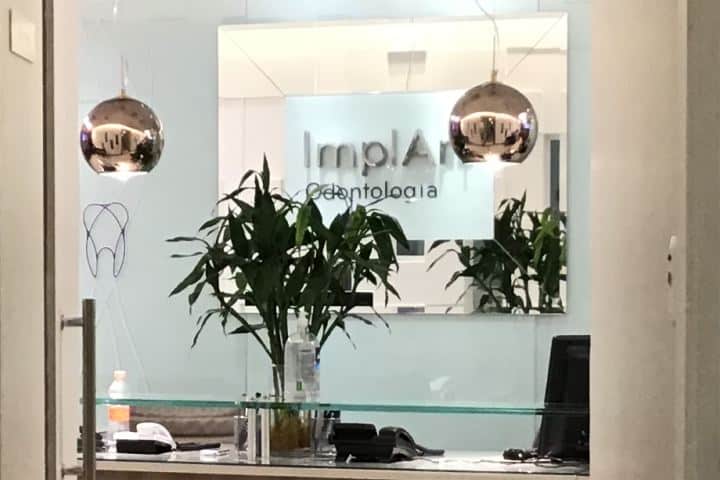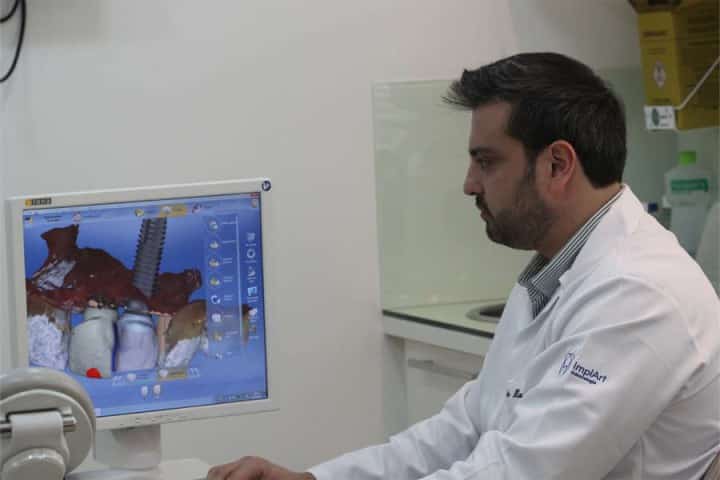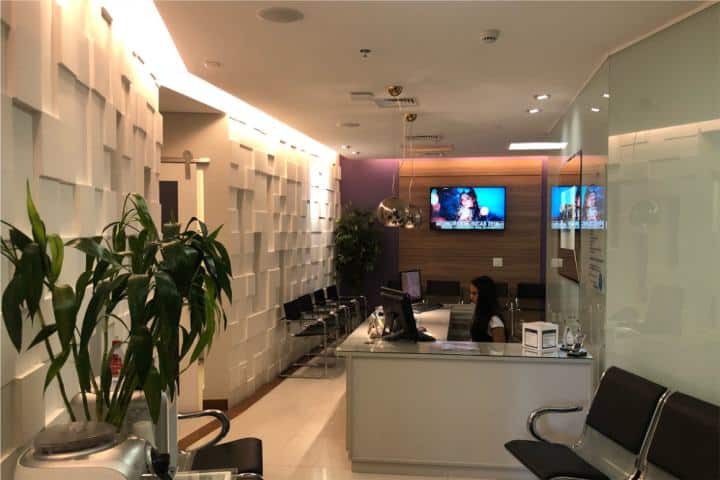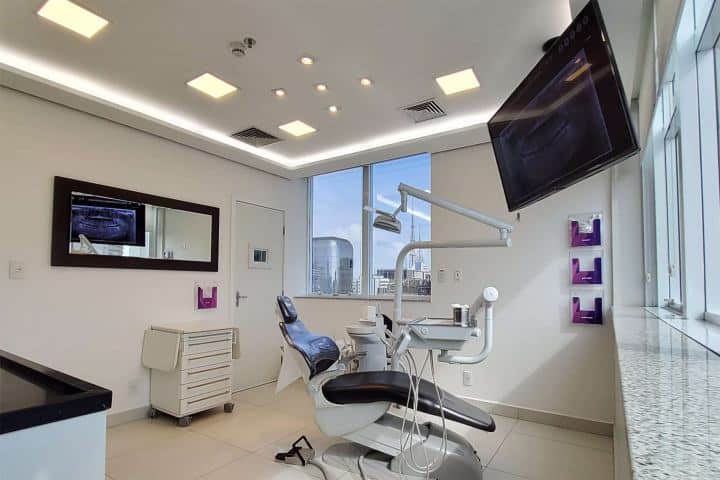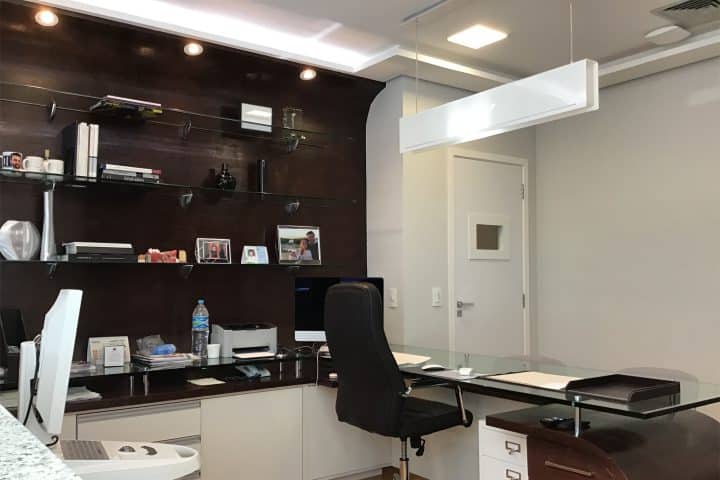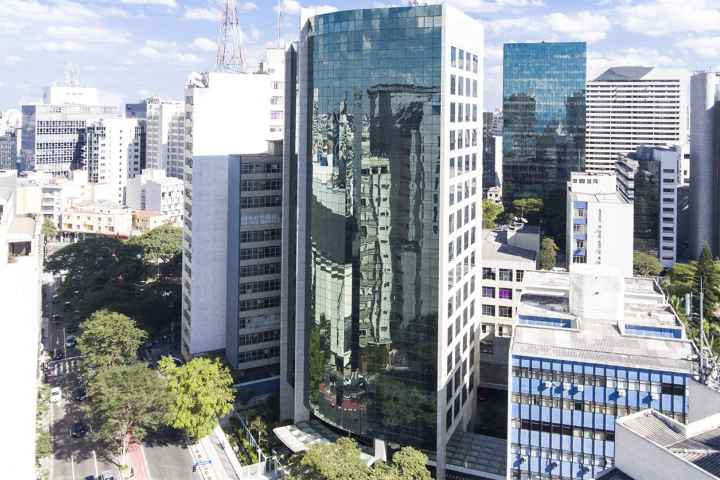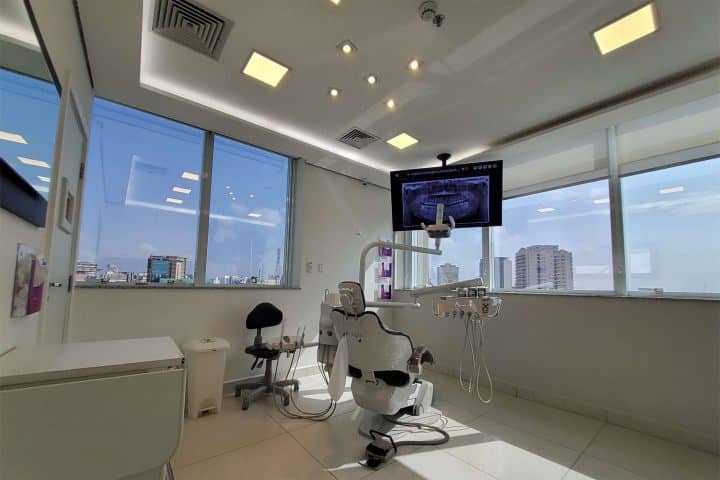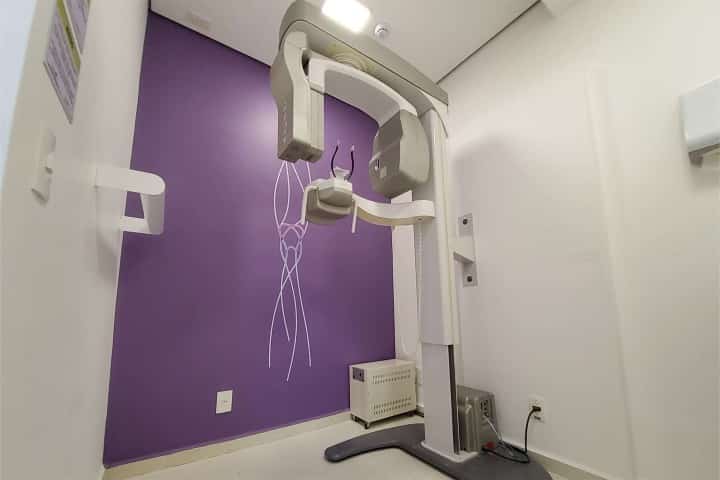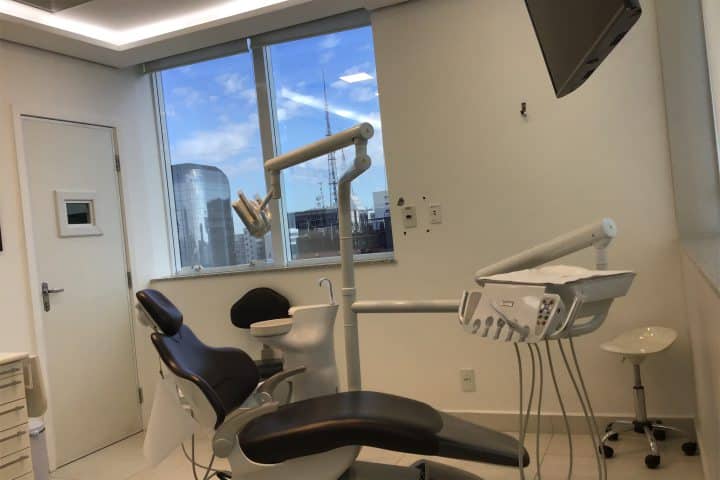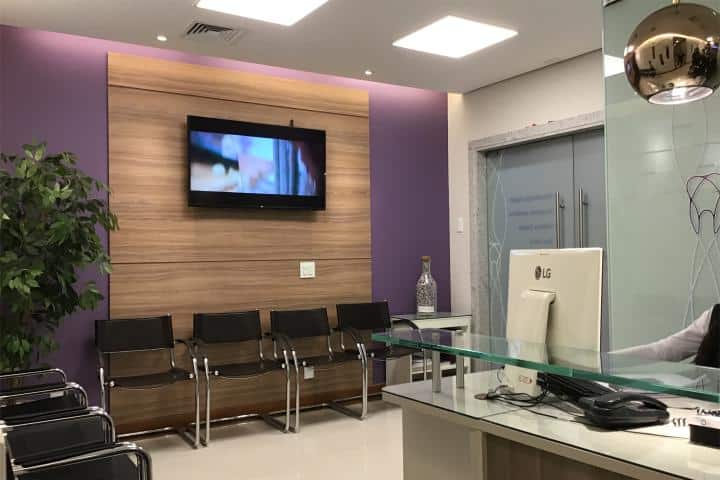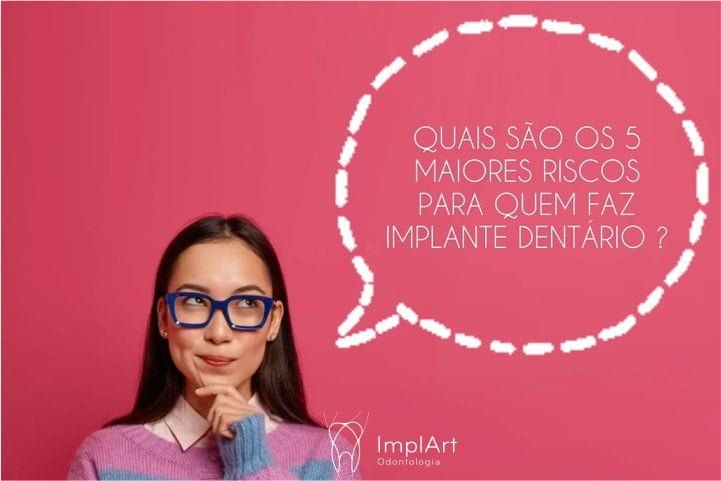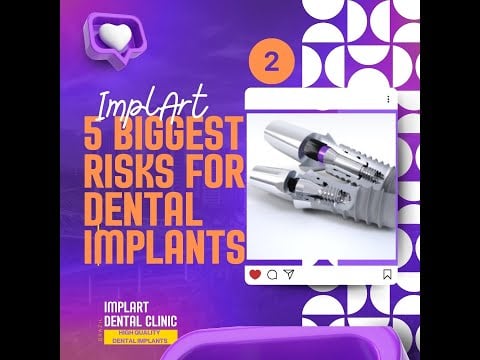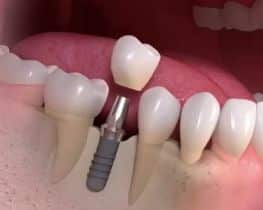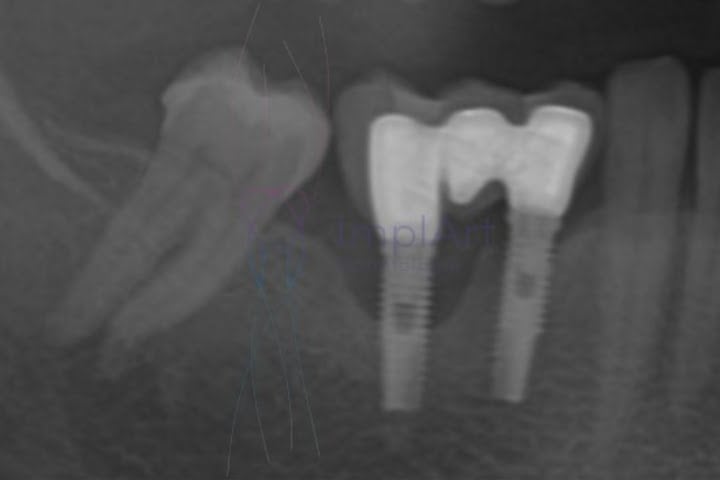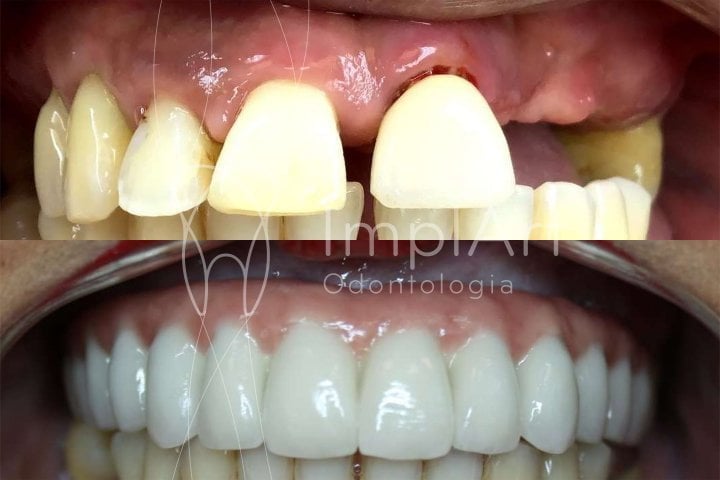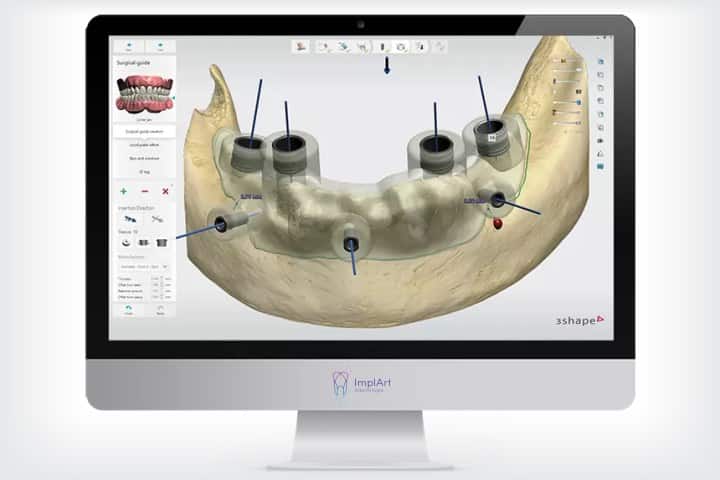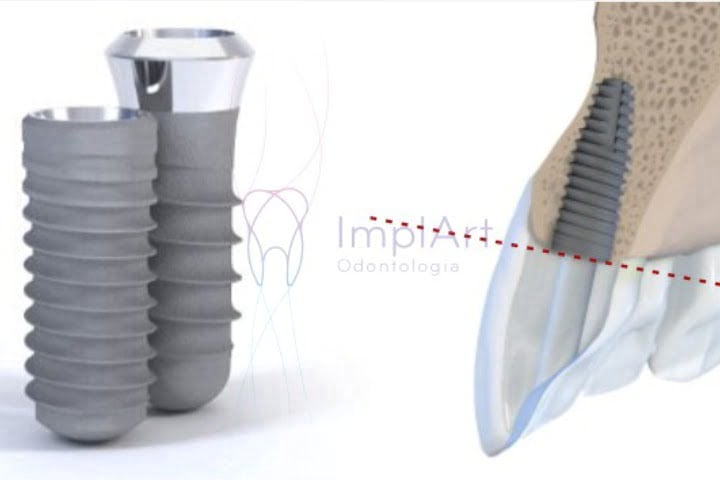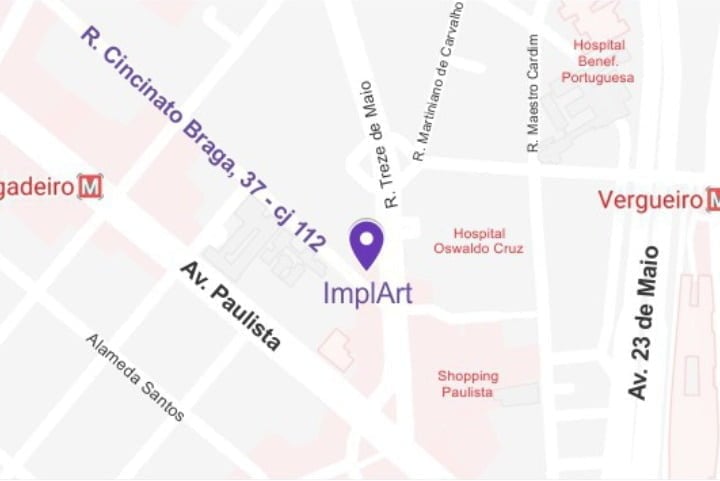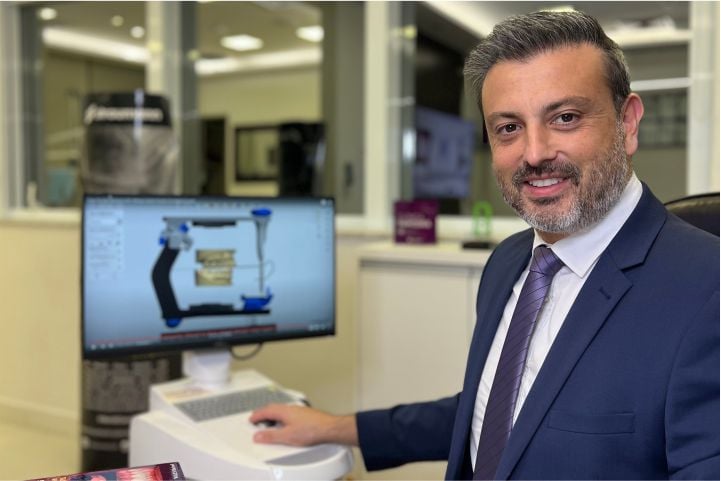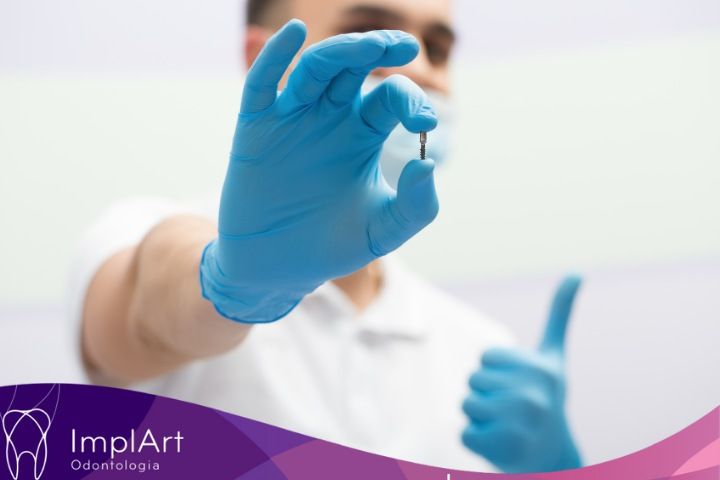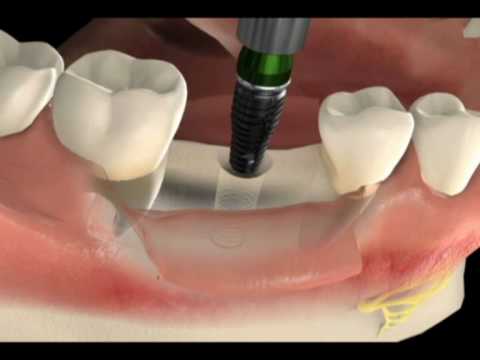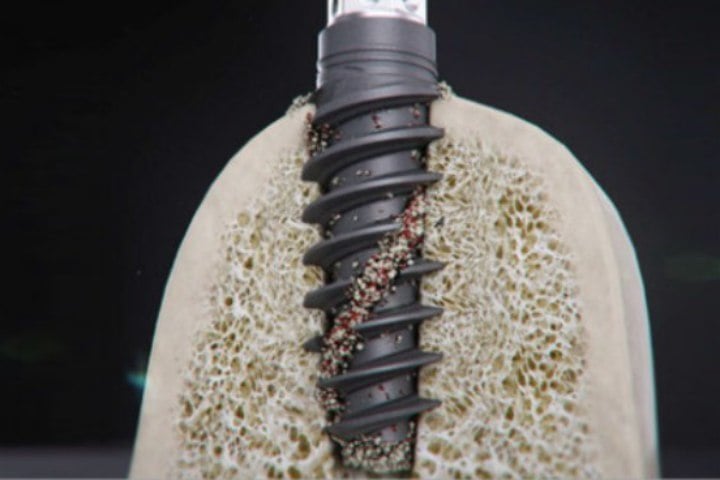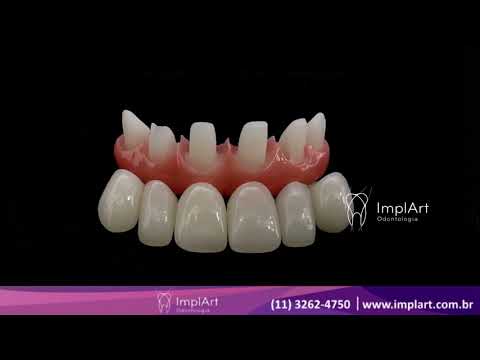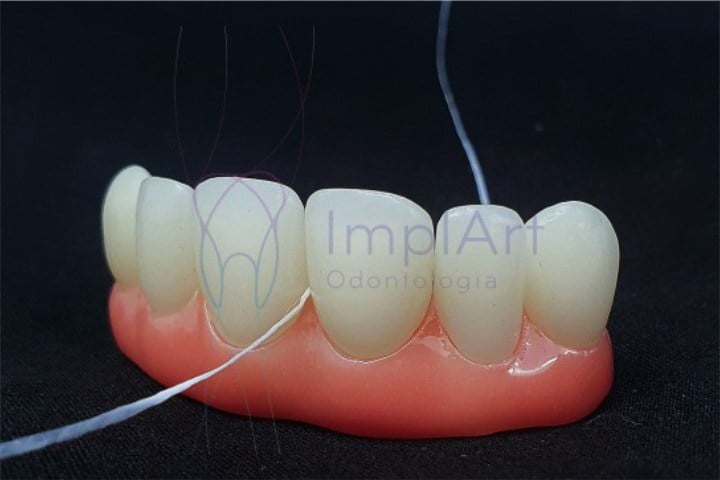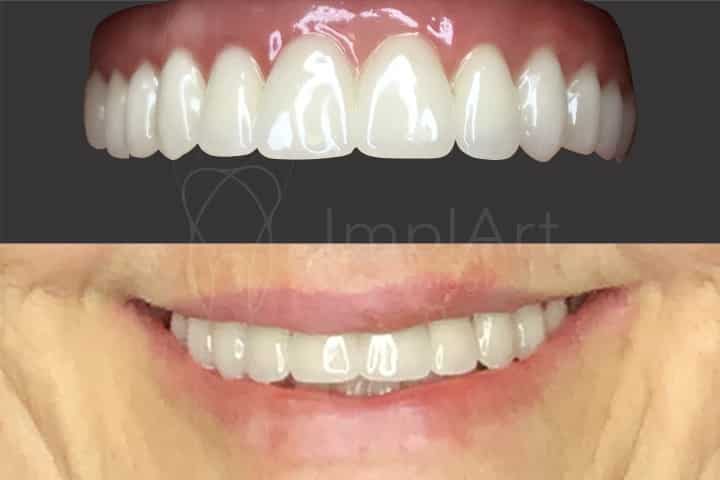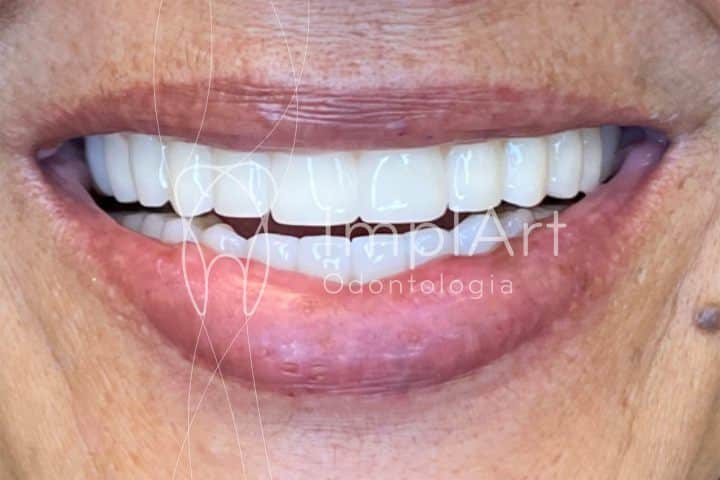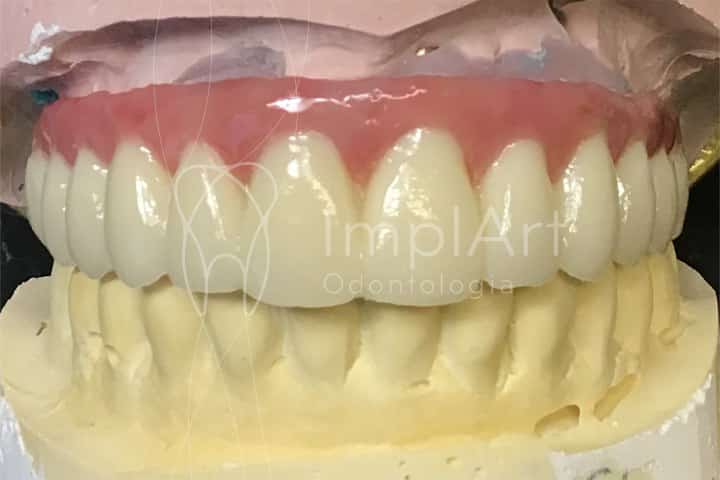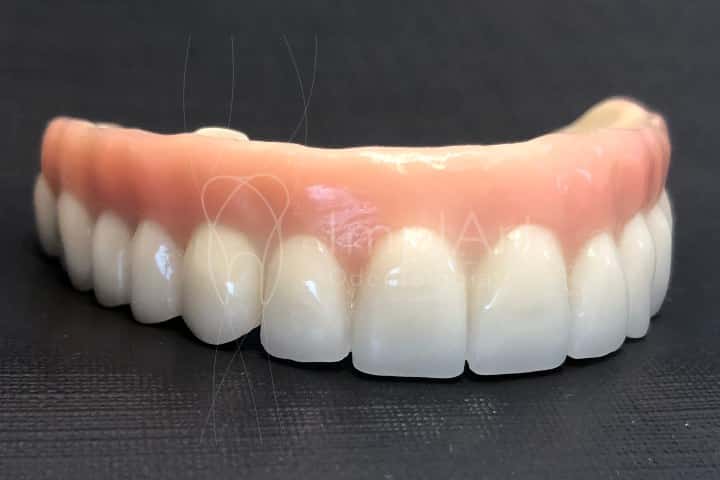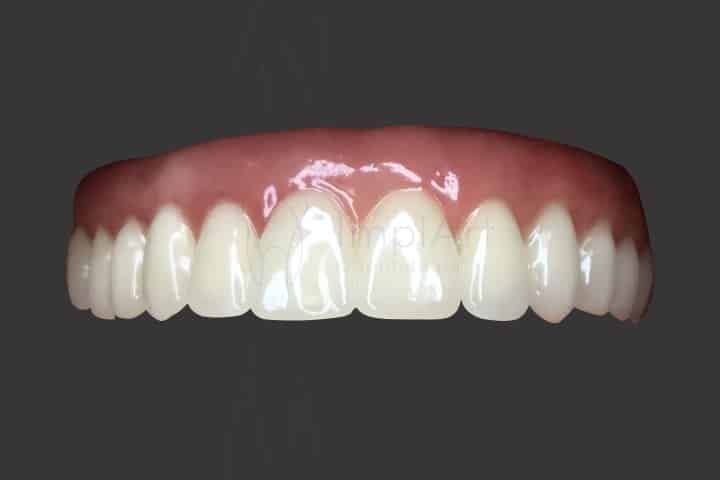Dental Implants at ImplArt Dental Clinic Specializing in Dental Implants
Get to know the ImplArt Dental Clinic, a specialist dental implant clinic in São Paulo. Clinica Dentaria ImplArt has a complete team and structure for you to carry out your implant surgery with peace of mind and high-quality materials.
We offer the most modern treatments with a structure ready to receive the patient according to high international standards. In addition, we offer the best brands of dental implants for you to choose from, various types of implants and the best team of specialists in implant dentistry. So if you’re looking for an implant clinic that works with high technology and modern materials, you’re in the right place!
It’s important to know that there are different types ofdental implants, and that they are not all the same. The Swiss brand Straumann offers fast-healing dental implants, as well as the latest white implant, the ceramic dental implant. The zirconia implant is the only non-titanium implant, and is therefore an option for those looking for a metal-free dental implant treatment.
Implants can have different healing times, so it’s important to choose which one to use before surgery. Osseintegration times for dental implants can vary from 1 to 6 months. Therefore, choosing the ideal type of dental implant is very important, because once implanted, the healing period for each implant must be respected. With Clinica Dentaria ImplArt, aclinic specializing in implants, you will certainly have all these options at your fingertips!
Fast healing dental implant
Fast-healing dental implants, full-mouth implants, zirconia prostheses, ceramic protocols and dental contact lenses make the ImplArt dental clinic much more than just a specialist implant clinic. We take care of our patients’ oral health as a whole, offering the most modern techniques available in dentistry today. Our clinical director, dental surgeon and implant dentist, Dr. Roberto Markarian, is a reference in dental implants and modern computerized prostheses.
For those who want a quick implant treatment, the ideal is to use the Slactive dental implant from the Swiss brand Straumann and a fixed prosthesis in Zirconia or a dental crown in Cerec Pure Porcelain. Both materials are completely made using computer graphics and a 3D printer. Because they use modern computerized systems, the Translucent Zirconia fixed prosthesis speeds up implant treatment, even if it is a protocol prosthesis. In this way, the treatment, even if it is a protocol prosthesis, is more precise and faster because it requires fewer treatment steps.
Dental implants – Quality of life and self-esteem back
What are dental implants and dental implant clinics?
This is a titanium or all-ceramic post (Straumann or Neodent ceramic implant ), which is surgically placed in the jawbone and has the function of replacing the root of a lost tooth. Tooth loss can occur as a result of trauma, tooth decay, gum infection or periodontal disease.
In these cases, after the dental implant has been installed, a dental prosthesis is attached which has the function and appearance of a tooth.
Treatment at the ImplArt Dental Clinic, which specializes in dental implants, aims to restore masticatory function, oral health and the aesthetics of the smile, giving people back their quality of life and self-esteem.
Treatment with dental implant pins is more efficient than treatment with conventional removable prostheses, known as dentures, and provides much more comfort for the patient, both when smiling and chewing.
Currently, for those looking for a metal-free treatment, either due to metal allergies or preference, the combination of ceramic implant and porcelain crown, or computerized Pure Zirconia, are ideal.
As we are a clinic specializing in dental implants, we have all the support we can offer patients, and a wide range of implant types.
As we are a clinic specializing in implants, we have the knowledge and know-how to identify the most diverse types of implants in patients who may have already had their surgery elsewhere and don’t know which implant was used.
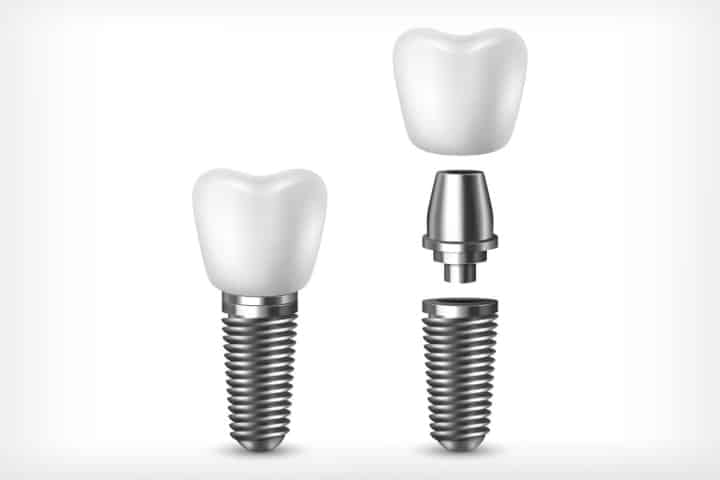
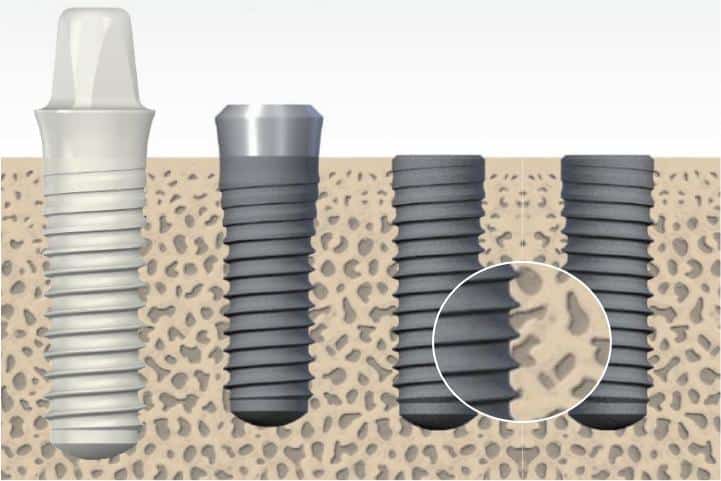
Do dental implants last forever? How is the osseointegration of the titanium dental implant?
As soon as the dental implant screw is placed, there is a phenomenon of progressive healing of the titanium surface with the bone, called osseointegration.
The osseointegration of the dental implant takes place through the formation of calcium on the surface of the implant, which occurs through delicate and complex biological and molecular phenomena. The healing time of the dental implant will depend on the type chosen, and will be confirmed by the implant specialist, implant dentist. Here you will have all the information you need for your implant, because we are a specialist implant clinic, with knowledge and vast experience in implant dentistry.
However, the time until the implant is sufficiently integrated can vary depending on a number of factors:
- The quality of the bone in the region
- The initial stability of the implant upon insertion
- The implant design model used
- The type of implant surface
- The patient’s general health
Healthy osseointegration is therefore responsible for the stability of dental implants and fixed dental prostheses, offering patients the security and comfort to chew, speak and smile. External factors such as smoking and poor oral health can hinder implant osseointegration.
It is certainly expected that the dental implant will last forever, i.e. once osseointegration has taken place, in healthy patients, it should remain integrated into the bone.
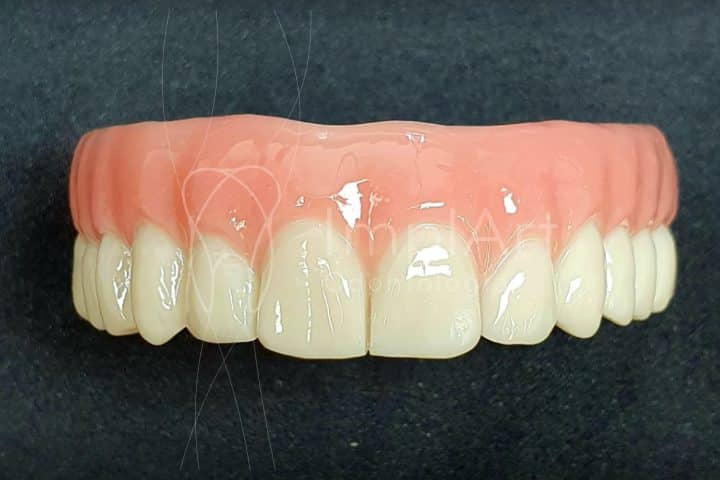
Advantages of dental implants
The experience of having fixed teeth with implants is far superior to using an uncomfortable mobile prosthesis. A tooth implant will receive the fixed prosthesis, and will also not require frequent or specific maintenance.
In the case of total implants, the brushing technique should be improved according to the instructions given by the dentist specializing in dental implants. Dental implants can be recommended for almost anyone who suffers from missing teeth, whether a few teeth or all the teeth in an arch.
However, each implant case needs to be assessed individually in order to plan the most appropriate treatment. However, the good news is that ImplArt is a specialist dental implant clinic that has the expertise and knowledge of the most modern techniques to solve missing teeth.
We have the experience to solve the most difficult cases of oral rehabilitation, using surgical or prosthetic techniques. See examples of before and after with osseointegrated implants at ImplArt, a clinic specializing in implants.
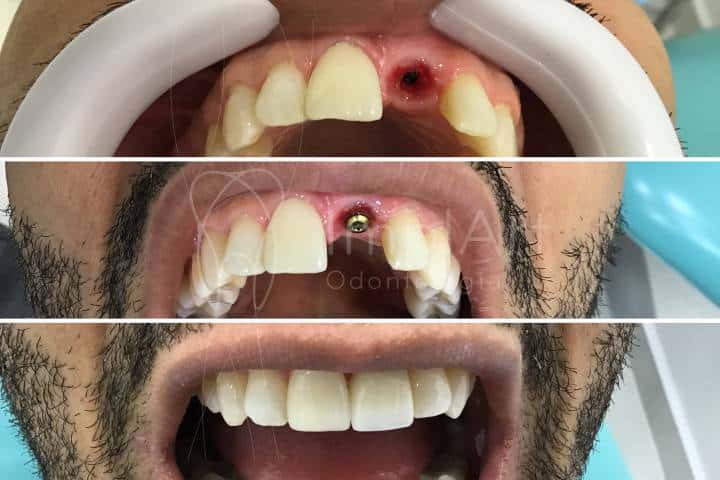
Single tooth implant – one tooth
Single-tooth implants have great advantages and should be used whenever possible, preferably with same-day surgery if there is bone in the same place as the tooth extraction.
- Neighboring teeth remain intact
- The new crown is attached directly to the implant, which makes it possible to floss like a natural tooth
- Excellentaesthetic and functionalresults
- Ease of treatment, as the prosthetic components are prefabricated
- Unaffected by caries and infiltration
- It is possible to place a temporary crown immediately after implant placement (immediate loading)
- The installation of the implant prevents or stops bone resorption.
Partial dental implant – several teeth
Losing multiple teeth can affect your ability to chew, as well as the beauty of your smile. Certainly the best option for replacing several teeth is the placement of dental implants and the fixing of a dental prosthesis.
Partial dental implants are recommended for people who have lost some teeth in between or in the same area of the mouth. A partial implant treatment is a much more efficient alternative to a conventional bridge.
Fixed prostheses on dental implants offer better aesthetic results compared to removable prostheses, dentures, and are important for preventing bone resorption and preserving oral health.
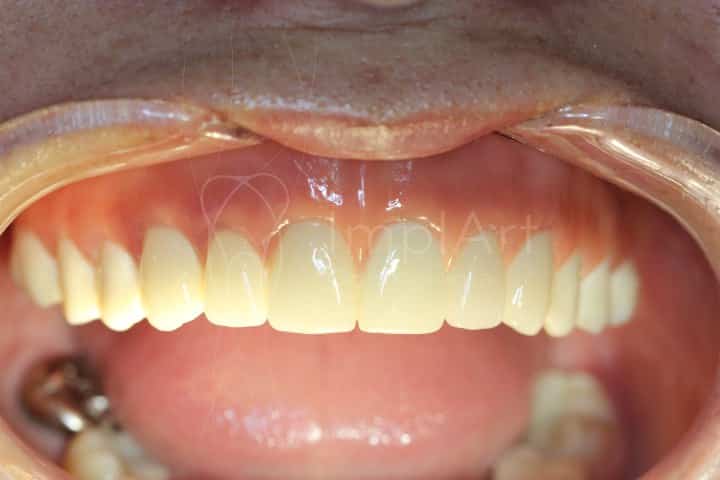
Dental implants for all teeth – total or complete
Total dental implants are recommended for people who have lost all their teeth. The loss of all teeth usually occurs due to periodontal disease or a combination of caries and inadequate oral hygiene.
There are strategies for replacing the teeth of an entire arch with a fixed prosthesis (also known as a protocol prosthesis) or a removable prosthesis (overdenture), but fixed prostheses are the most commonly used.
In an all-tooth dental implant treatment, the pins are strategically distributed through the bone of the dental arch in order to provide sufficient support for the planned dental prosthesis.
ImplArt is a clinic specializing in dental implants carried out with computerized planning of guided total implant surgery. The fixed total implant treatment is capable of giving patients the incredible sensation of chewing and speaking safely and comfortably.
The fixed dental prosthesis attached to the implants should also improve the aesthetics of the patient’s smile, which ultimately improves their self-esteem.
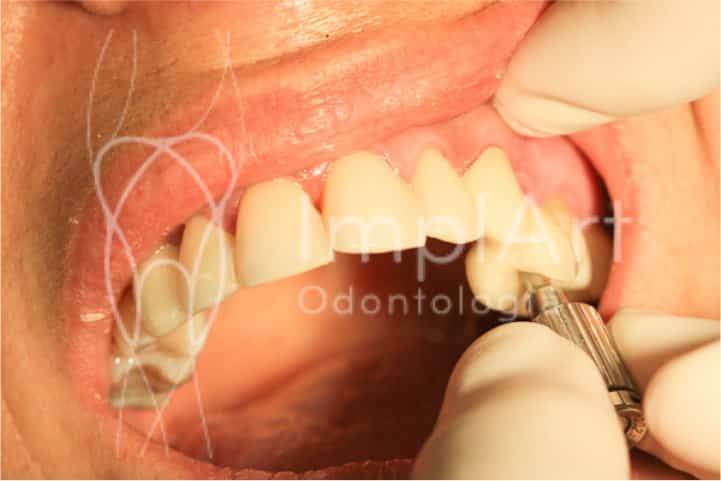
Immediate loading for dental implants
Due to scientific advances, it is now possible, in selected cases, to go into the office without teeth and leave at the end of the day with all your teeth fixed on dental implants (temporary prosthesis).
This technology, known as immediate loading, provides patients with great satisfaction due to its rapid results. In short, immediately loaded implants can be used in the following cases:
- Immediate loading for total implants (replacement of dentures with all teeth fixed)
- For implants of several teeth (usually teeth or tooth roots with periodontal disease, badly decayed teeth or old dentures)
- For a single tooth (mainly front teeth)
When can immediate loading be performed?
The dental implant technique with immediate loading can be performed when bone quantity and quality are normal and also when occlusal habits are favorable for the procedure so that there is no chewing overload on the site.
Therefore, the immediate loading technique depends on certain conditions in the patient’s dental arch and general oral health. These conditions are assessed individually during your consultation with the implant dentist.
The patient is never left without teeth during implant treatment. A temporary dental prosthesis is designed to offer greater comfort and aesthetics.
Different implant pin models can advance or delay healing and therefore the delivery of the definitive prosthesis. Discover the fastest implants currently available from the Swiss brand Straumann.
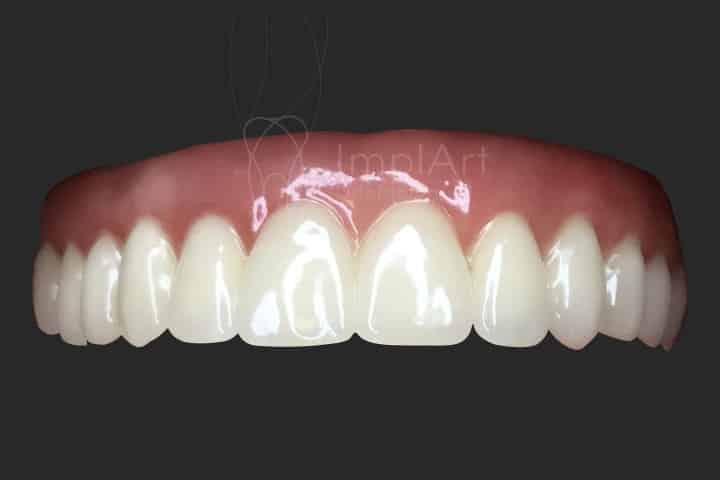
Fixed dental prosthesis on implants – types of materials
Implant treatment is the main form of aesthetic and functional rehabilitation for patients who have lost their teeth.
The absence of one or more teeth compromises chewing, speech and the aesthetics of the smile, so a fixed prosthesis on implants is capable of restoring the edentulous person’s security and self-esteem. In summary, rehabilitation basically goes through 3 relevant phases:
- The placement of dental implants
- The healing phase (in which the patient wears a temporary prosthesis)
- Fixing a definitive prosthesis on implants (conclusion)
We therefore have a variety of materials that can be used to make a permanent dental prosthesis:
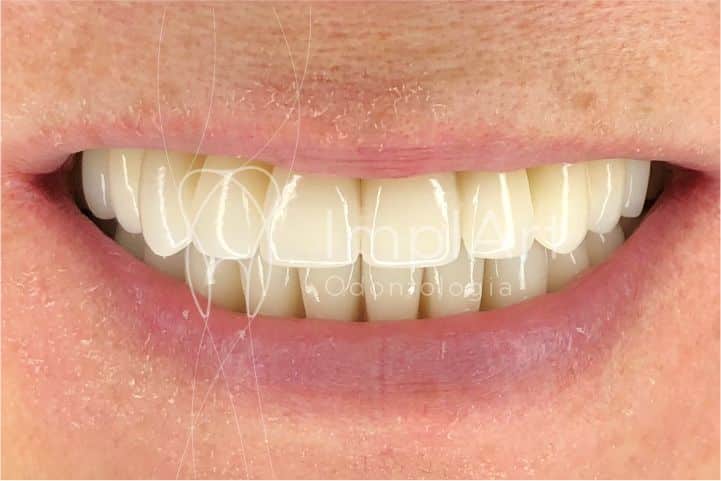
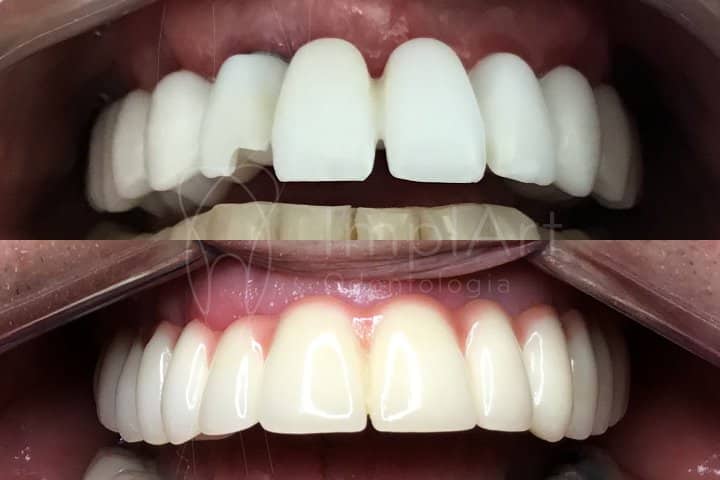
Pure porcelain fixed prosthesis for dental implants – Translucent zirconia (metal free)
It is a white ceramic structure called zirconia, covered with an aesthetic porcelain sculpted to the shape of the teeth.
It is therefore a new and technologically innovative material, as the prosthesis is completely designed on a computer and made with the help of electronic scanners and 3D printers. The zirconia fixed prosthesis is the material that offers the best aesthetic result because it does not contain metals in its composition.
Zirconia is a porcelain that has characteristics that are equally comparable to natural teeth, including shade, translucency and resistance.
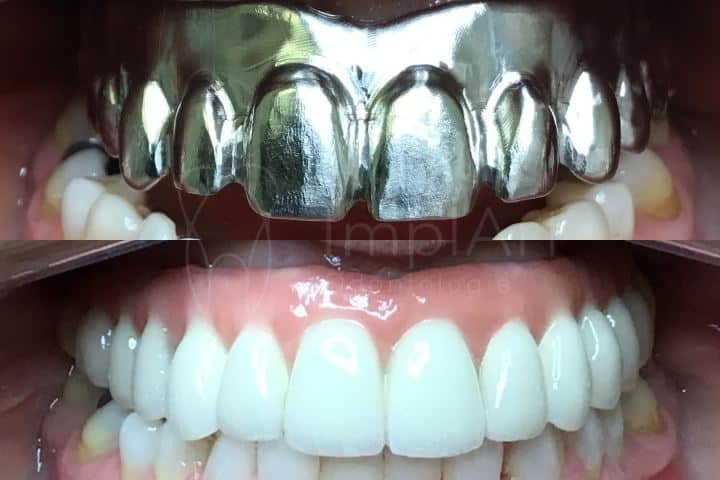
Metal-ceramic prosthesis on dental implants (porcelain + metal)
This is a prosthesis with an internal metal structure (titanium, Ni-Cr or Cr-Co) and an aesthetic porcelain finish that is hand-sculpted in the shape of the teeth. The result is the strength and aesthetics of porcelain, which leaves the prosthesis with aesthetics and beauty similar to natural teeth.
Although it has a small disadvantage compared to pure porcelain prostheses (which is the possibility of a grayish line appearing at the level of the gums, if the patient suffers some gum recession over time, which can lead to an aesthetic compromise in the smile).
The porcelain prosthesis (ceramic protocol) has advantages over the resin prosthesis, such as better durability and resistance to wear, as well as no color changes over time.
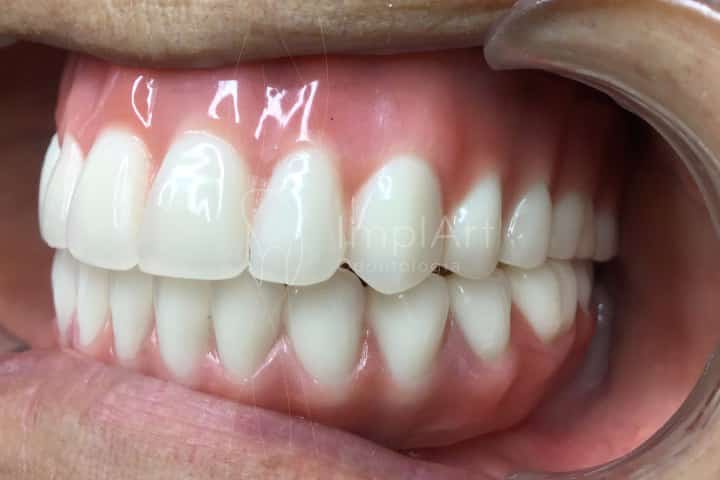
Fixed resin prosthesis on dental implant (resin + metal) – Acrylic
Also known as the Bränemark protocol prosthesis, this model has an internal metal structure and an aesthetic resin finish. The teeth are made of resin and you can choose the color, shape and size of the teeth.
However, this material has a disadvantage compared to previous ones, which is the possibility of color change (yellowing) over time. The choice of prosthesis material should be made jointly by the dentist and patient.
Watch the video on prosthetic materials for dental implants by clicking here.
Do dental implants hurt or not?
The dental implant procedure is easier than you might think and doesn’t hurt a bit! Due to advances in techniques, dental implant surgery today is less invasive, avoiding excess tissue damage, pain and discomfort.
During the surgery, the patient feels no pain because it is performed under local anesthesia. In addition, ImplArt uses techniques that reduce discomfort during surgery and make the recovery period more peaceful.
Some of the techniques that ImplArt Odontologia performs include computer-guided dental implant surgery, all-on-4 total implants, and less painful anesthesia. In short, it avoids unnecessary cuts and damage to bone and gum tissue.
ImplArt also uses Piezosurgery surgical ultrasound, which cuts through hard tissues such as bone and preserves soft tissues such as gums, nerves, membranes and blood vessels.
In this way, the system allows the surgeon greater surgical precision and better visibility during surgery, as well as avoiding risks in the dental implant. See more photos of work carried out at ImplArt by clicking here.
The best brands and types of dental implants
There are several brands and models of dental implants available in Brazil, and for each application there is an ideal model. At ImplArt we use certified materials.
Come in for a consultation and we’ll find out which implant is best for you. See below for interesting articles on some types of tooth implants:
- Implants for deeperbone placement
- Straumann BLT TaperedImplants
- The new types of implant pins
- Shorter implants for when there is little bone height
Are you afraid of dental implants?
Believe me, dental implant surgery is easier than you might think and there’s really nothing to be afraid of.
Dentistry has come a long way with the use of less invasive techniques to offer patient comfort and, above all, ImplArt has incorporated today’s most effective techniques into its practice to minimize any discomfort.
ImplArt is always in line with the latest developments in the world of dentistry. It uses advanced techniques to ensure that its patients have a quiet, minimally invasive, comfortable and painless surgery.
Get to know our resources and see that it’s worth doing your aesthetic and functional oral rehabilitation with dental implants, without fear.
Humanized treatment with a dental implant specialist and care for those who need teeth implanted
Fears and phobias of dentists usually stem from previous bad experiences. Examples include previous treatments that were poorly carried out, without respect for the patient’s needs or painful treatments.
ImplArt has a great deal of experience in dental implants, as well as dealing with people’s expectations and fears in this regard. Over the years, we have received many people who were terrified of undergoing dental implant surgery, as well as the aftermath.
We are ready to listen to your needs in implant dentistry and oral rehabilitation
At the end of the treatment, benefiting from modern techniques and humanization, it is common to see a reduction in the patient’s phobias and even a cure for the fear ofdentists(odontophobia). We affirm that the advantages of good oral health and an aesthetic smile are well worth it.
ImplArt’s team of dental implant specialists is committed to welcoming and understanding all the needs, fears and traumas that people bring with them. Don’t let fear stop you from enjoying the benefits of a fixed prosthesis on implants.
We are ready to help you with your case and restore masticatory function and the aesthetics of your smile!
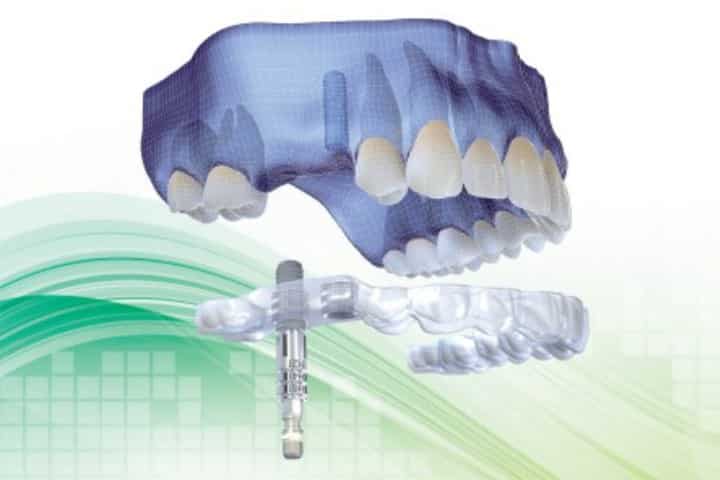
Guided dental implant surgery – less invasive and faster
Computer-guided implant surgery is a technique that makes it possible to carry out the procedure in a way that is less invasive and therefore more comfortable and painless. In addition, guided surgery favors a faster recovery in the post-operative period of dental implants.
In order to plan the case, the patient undergoes a CT scan. The 3D images from the CT scan, combined with a digital mold of your mouth using an intraoral scanner, are used to make a plastic guide.
This implant with surgical guide acts as a template with the exact indications where the implants should be positioned according to the bone volume.
In this way, unnecessary cuts in the gums are avoided in most cases. This certainly means a lot of comfort for the patient in the post-operative recovery, as well as faster surgery.
Deep sedation for implant surgery
Sedation is a technique indicated for those who are very afraid of the dentist, afraid of feeling pain, as well as the noise of the motor, the needle, blood, etc. It allows the patient’s level of consciousness to decrease during the surgical procedure.
But sedation does not affect the ability to breathe and respond to physical stimulation and verbal commands. An anesthesiologist applies a sedative drug intravenously before the procedure.
The patient then falls asleep, but is continuously accompanied by the doctor and monitoring devices as the surgery takes place. In practice, it’s like a deep, relaxing sleep for the patient.
Most of the time, there are no memories of the procedures. The patient only wakes up when the procedures are finished, and the doctor continues to monitor their recovery until they can walk out of the room.
The sedation procedure with a dental implant specialist becomes simple, as well as comfortable for the patient, because when they wake up all the work has already been done. Read more about sedation.
There is another form of gas sedation (nitrous oxide), which we do not use at ImplArt. In our experience, gas sedation is very superficial and is not effective for patients who are truly “afraid”.
* Don’t confuse sedation with general anesthesia. General anesthesia is much more complex and can only be done in hospital.
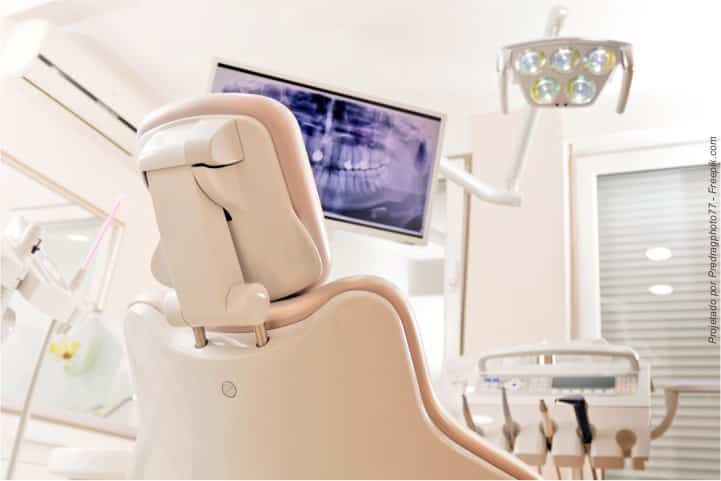
Dental Day Clinic with dental implant specialist – Faster treatments
The Day Clinic or Dental Spa is a type of intensive treatment offered at Implart, a specialist in dental implants. Among other advantages, it is suitable for those who are afraid of dental implants and want a quick dental implant treatment. In a Day Clinic, the patient can arrive at the office without teeth and leave with a dental implant and temporary prosthesis on the same day (in selected and favorable cases).
Intensive treatment is a great relief for those who are afraid of implants, because they spend less time in the dental implant specialist’s office in order to solve their problem. However, the most important thing is to carry out as many procedures as possible in the shortest possible time.
ImplArt is a modern specialist clinic with a complete structure for this purpose. Digital dentistry techniques, computerized molds and fabrication of teeth, our own laboratory and trained staff speed up treatment.
- Read about fractured teeth may need urgent replacement with dental implants
- Read about prostheses, implants and treatments for the elderly
- Find out more about dental implants for pregnant women ( implants are possible during pregnancy in some cases)
- Rapid tooth replacement in 21 days with Straumann implants and computerized teeth.
Below are photos of some of the treatments carried out at the ImplArt Clinic, which specializes in implants
The photos are of cases of Zirconia protocol prosthesis, upper protocol prosthesis, lower protocol prosthesis, computerized dental crown.
Check out the photos of the implant treatments below and see the transformations! If you’d like to see even more cases, visit our Photo Gallery by clicking HERE.
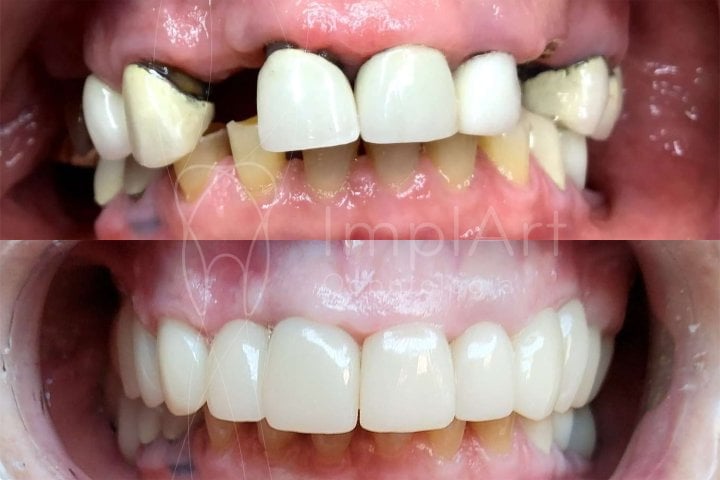
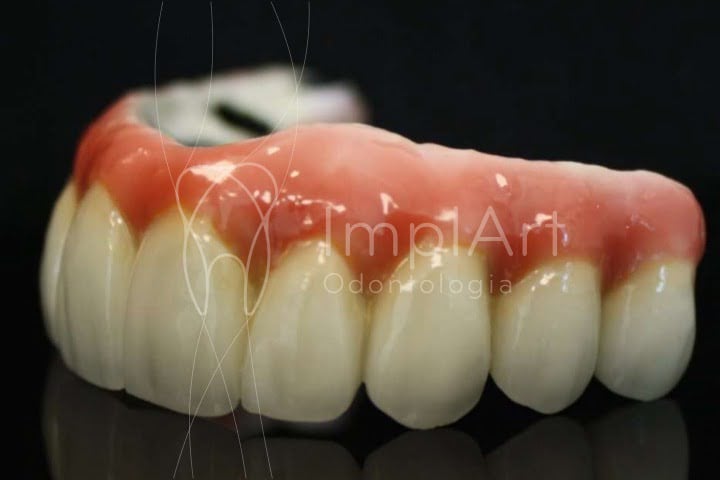
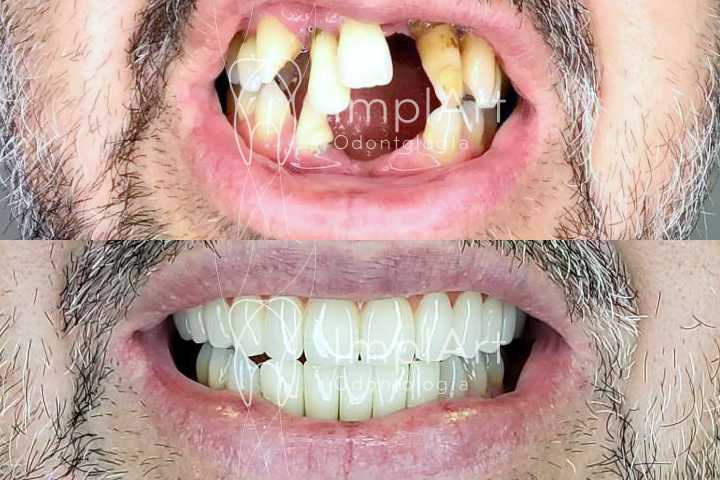
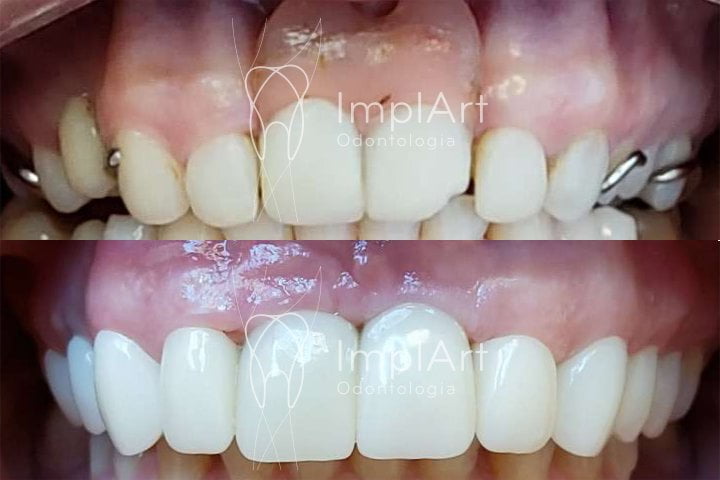
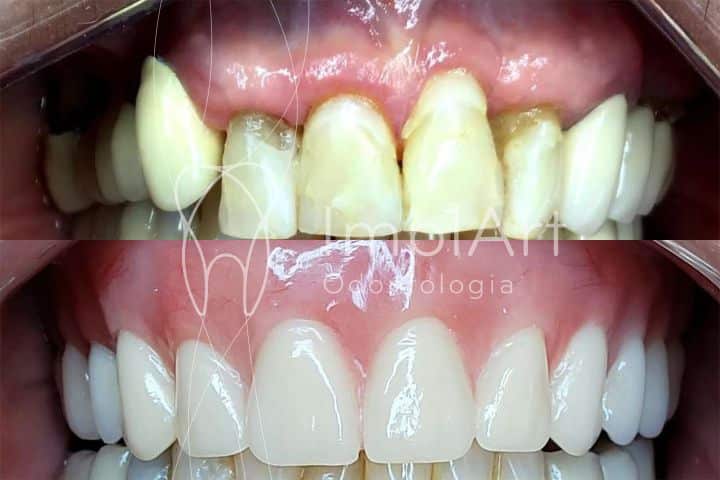
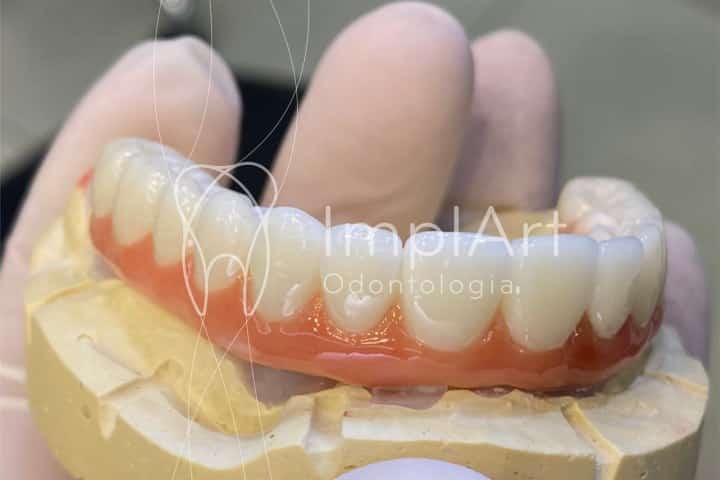
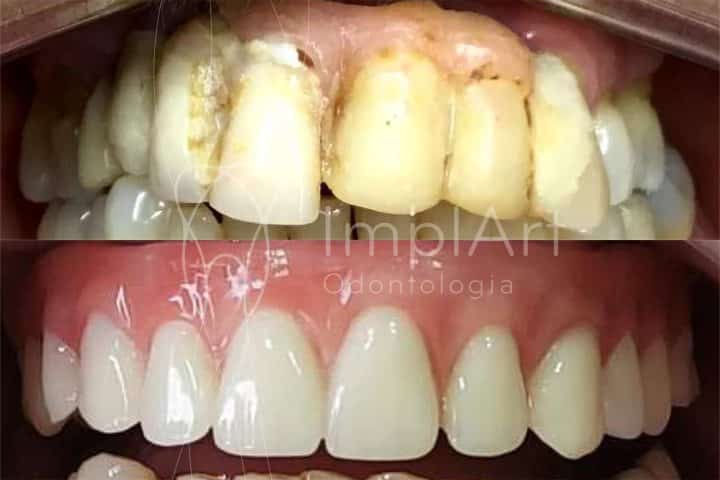
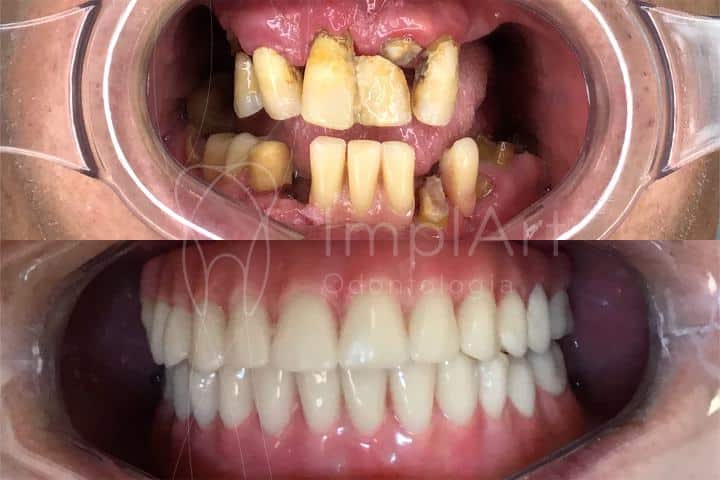
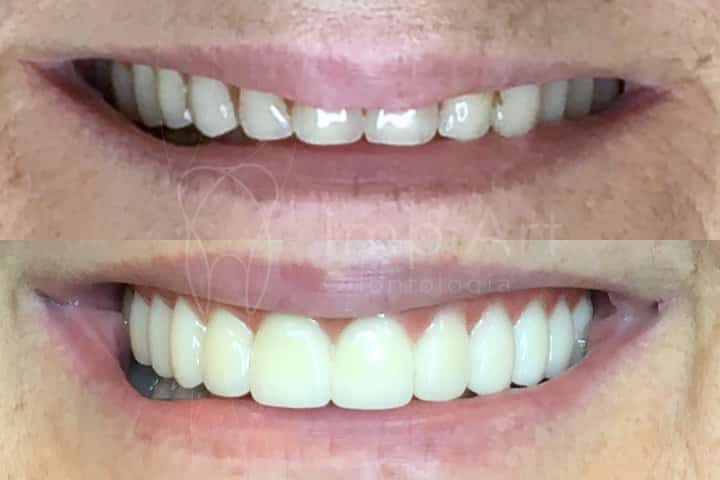
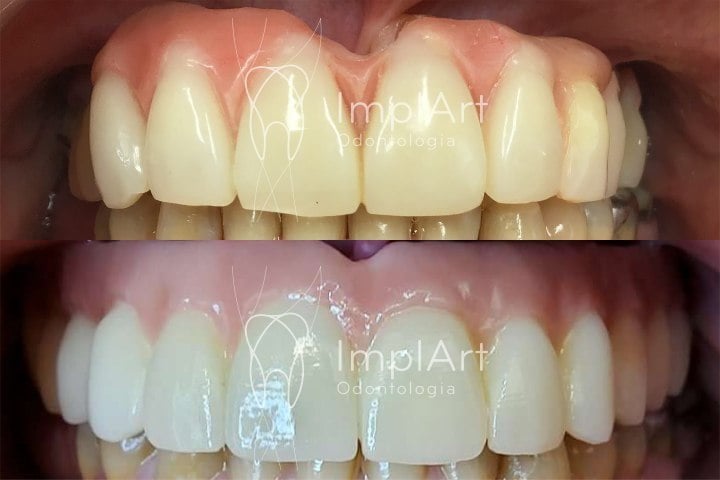
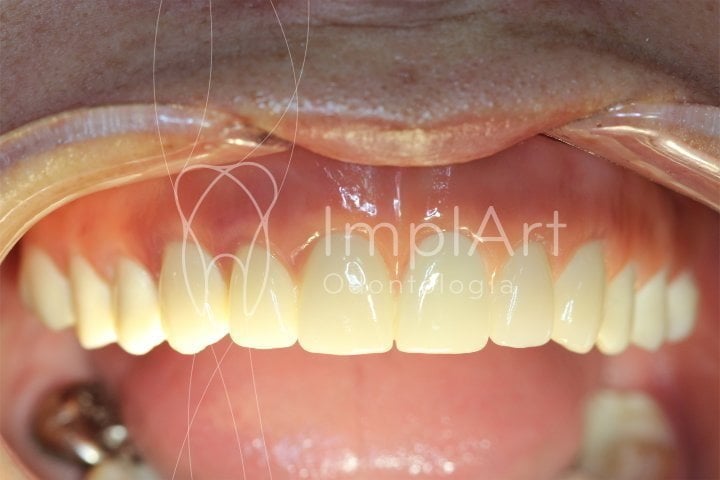
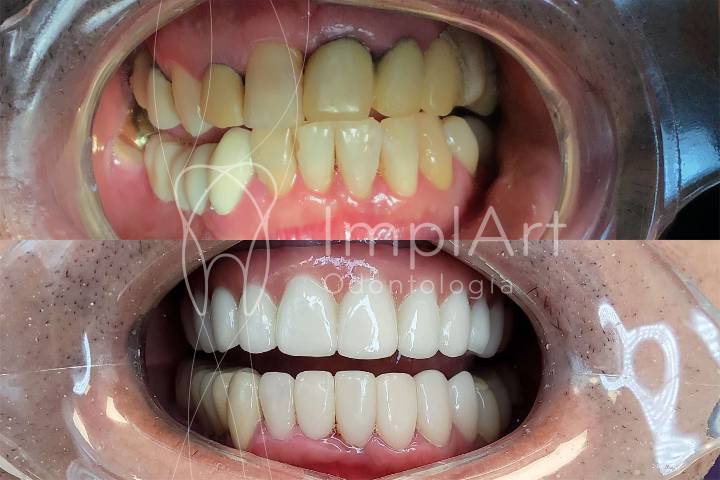
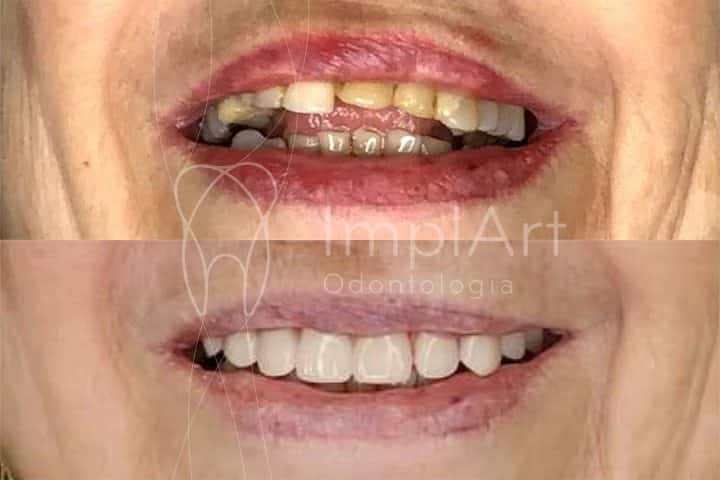
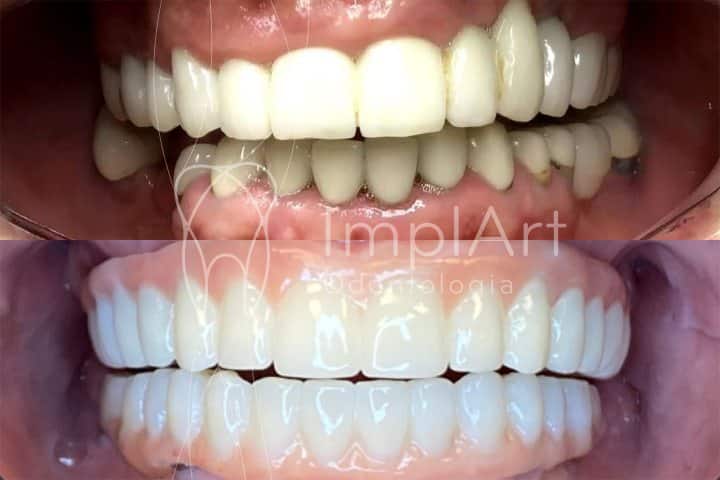
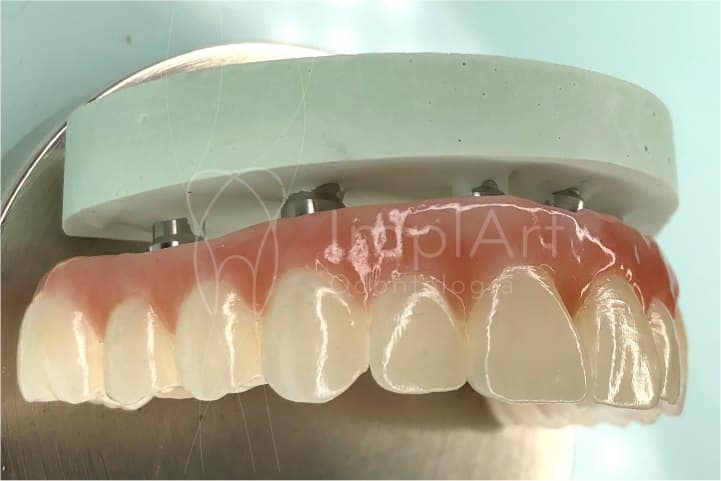
Price and value of dental implant treatments and dental aesthetics │ Dental implant value and average price with dental implant specialist
We often receive calls, emails and messages from people asking about the prices or values of dental treatments, especially dental implants and prosthetic protocols.
However, we always try to explain that the value and price can only be answered through a dental consultation with a specialist in dental implants, an implant dentist. The ImplArt Dental Clinic specializes in dental implants and takes this matter very seriously.
How much is a dental implant? Do I find out the cost at the appointment?
There are two main reasons why values are explained live:
- The first is that the Code of Ethics of the Federal Council of Dentistry prohibits dentists from providing consultations online – not in person. Nor can dentists advertise the price of dental treatment online, let alone the cost of dental implants. The practice of posting average prices on websites constitutes serious misconduct before the Dental Council.
- Secondly, complex dental treatments such as implant dentistry can only be indicated after a careful assessment of the patient. It often happens that patients think they need teeth implanted, but in reality they first need braces, bone grafts or different types of dentures. Of course, different plans will lead to different values and prices.
What can influence treatment with a dental implant specialist?
There are numerous factors that influence the planning of a treatment. There are also various options for materials and techniques that influence the composition of a budget. In addition, a treatment that may be suitable for one person may not be the most appropriate for another.
An implant dentist is a professional who specializes in dental implants and is qualified to plan and carry out dental implants, as well as giving the necessary recommendations to keep teeth beautiful and healthy throughout life.
At Clínica Odontológica ImplArt, a clinic specializing in dental implants, we believe that dental treatment goes far beyond a simple monetary value.
There are important factors that influence the perception of value or cost-benefit, such as the health and well-being that healthy teeth provide, improved self-esteem and patient comfort during procedures.
In addition to the price, the relationship of trust between patient and dentist and our empathy for the patient are important, as they often bring with them anxieties, expectations, fear of implants, as well as trauma from previous experiences. How much does your smile cost you?
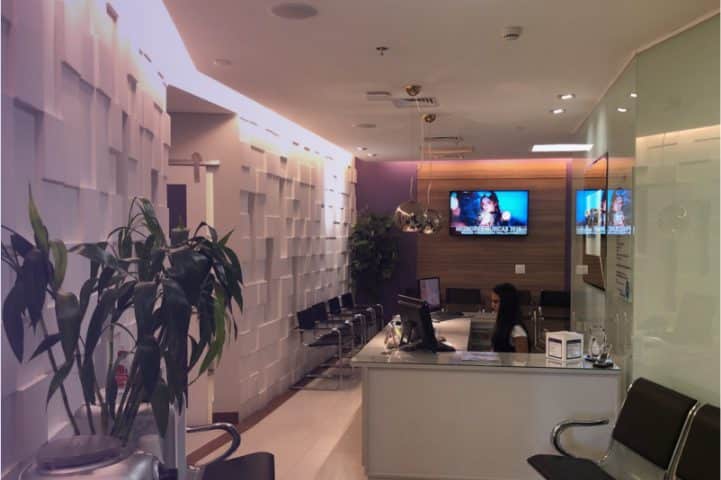
What is the first consultation with a dental implant specialistlike ? Is there a charge?
Yes, we charge for the first consultation. The patient will be assessed by the clinic’s director, Dr. Roberto Markarian, a specialist in dental implants, who has extensive experience in treatments for functional and aesthetic oral rehabilitation, with dental implants as well as dental prostheses.
If necessary, the patient may be asked to undergo some radiological examinations in order to help with diagnosis and treatment planning. For your convenience, some of the main dental tests can be carried out within the specialist clinic (at a separate cost).
If you already have previous exams, bring all the recent ones (up to 1 year old) to your appointment, as they will be of great help.
My dentist doesn’t charge for implants, why do you?
We follow the rules of the CRO, the Regional Council of Dentistry, which specifies that dental services cannot be free, in the same way as medical consultations. Certainly, the culture in dentistry is changing and the number of dentists who charge for consultations is growing.
The dentist specializing in dental implants, implantodontist, who will be treating you has completed university studies and takes frequent postgraduate courses. Their time is valuable, as it is in other health professions. We also need to clarify that there is no such thing as a free dental implant.
Even in places where tooth implants are done at low cost, such as courses for dentists, the patient pays less, but there is always a price to pay.
Do you accept any dental plans that cover dental implants at ImplArt, a specialist in dental implants?
We are a clinic specializing in dental implants, used to receiving the most complex cases in dentistry.
However, we do accept plans for the reimbursement or free choice system. There are companies that offer their employees this system, in which they will later receive the amounts paid. In this way, we offer all the support that patients with dental plans may need to request reimbursement.
Most dental plans don’t offer cover for dental prosthesis, implants or aesthetic procedures, which are precisely the focus of our specialist clinic. However, we are able to offer the support that patients may need to request reimbursement for their dental treatment.
Read more frequently asked questions about dental implants
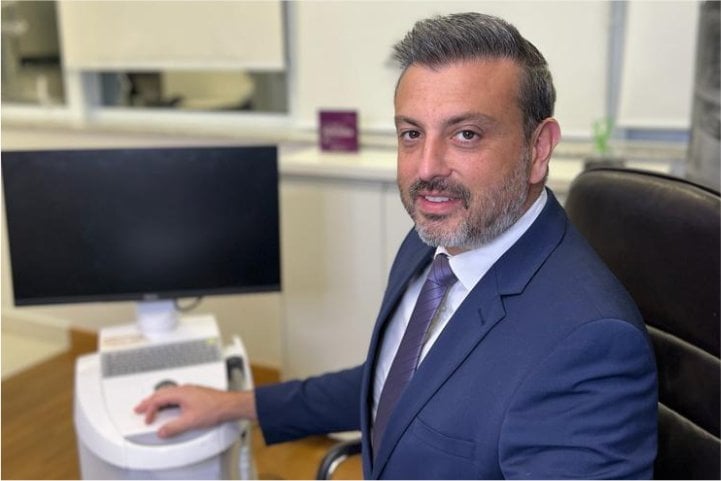
Dr. Roberto Markarian – Implantodontist – Specialist in dental implants
Dr. Roberto Markarian, an implant dentist, is the creator and coordinator of the ImplArt Odontologia dental clinic, one of the main technology centers and clinics specializing in dental implants, especially in aesthetic oral rehabilitation and implant dentistry in Brazil, located in the Paulista Avenue region in São Paulo-SP.
He holds a doctorate in implant dentistry, a master’s degree in dental prosthetics, two specializations in dental implants and dental prosthetics, as well as training courses in the field of dentistry, both in Brazil and abroad.
He is also a member of the ITI – International Team for Implantology, an organization linked to Straumann that brings together the world’s best specialists for the development of new products and techniques. Learn more about Dr. Markarian ‘s academic career and technical scientific knowledge by clicking here.
Conclusion on implants at the ImplArt Clinic
Designed by the Moran & Anders architectural firm, the ImplArt Clinic has modern facilities to serve patients in comfort. It should be noted that the Implart Dental Clinic is a dental implant clinic specializing in oral rehabilitation. It therefore offers the most modern materials and treatments to make your dental implant treatment safe, comfortable and fast. Also, for those who live far away, we can do a preliminary online consultation and plan your dental implant surgery remotely. Get in touch with us!
ImplArt Dental Clinic, Clinic specializing in dental implants

Watch more dental implant videos by clicking here

 Agende sua consulta agora por WhatsApp
Agende sua consulta agora por WhatsApp
